healthyverse_tsa
Time Series Analysis, Modeling and Forecasting of the Healthyverse
Packages Steven P. Sanderson II, MPH - Date: 2025-12-24
Introduction
This analysis follows a Nested Modeltime Workflow from modeltime
along with using the NNS package. I use this to monitor the
downloads of all of my packages:
Get Data
glimpse(downloads_tbl)
Rows: 163,894
Columns: 11
$ date <date> 2020-11-23, 2020-11-23, 2020-11-23, 2020-11-23, 2020-11-23,…
$ time <Period> 15H 36M 55S, 11H 26M 39S, 23H 34M 44S, 18H 39M 32S, 9H 0M…
$ date_time <dttm> 2020-11-23 15:36:55, 2020-11-23 11:26:39, 2020-11-23 23:34:…
$ size <int> 4858294, 4858294, 4858301, 4858295, 361, 4863722, 4864794, 4…
$ r_version <chr> NA, "4.0.3", "3.5.3", "3.5.2", NA, NA, NA, NA, NA, NA, NA, N…
$ r_arch <chr> NA, "x86_64", "x86_64", "x86_64", NA, NA, NA, NA, NA, NA, NA…
$ r_os <chr> NA, "mingw32", "mingw32", "linux-gnu", NA, NA, NA, NA, NA, N…
$ package <chr> "healthyR.data", "healthyR.data", "healthyR.data", "healthyR…
$ version <chr> "1.0.0", "1.0.0", "1.0.0", "1.0.0", "1.0.0", "1.0.0", "1.0.0…
$ country <chr> "US", "US", "US", "GB", "US", "US", "DE", "HK", "JP", "US", …
$ ip_id <int> 2069, 2804, 78827, 27595, 90474, 90474, 42435, 74, 7655, 638…
The last day in the data set is 2025-12-22 22:35:48, the file was birthed on: 2025-10-31 10:47:59.603742, and at report knit time is 1255.8 hours old. Happy analyzing!
Now that we have our data lets take a look at it using the skimr
package.
skim(downloads_tbl)
| Name | downloads_tbl |
| Number of rows | 163894 |
| Number of columns | 11 |
| _______________________ | |
| Column type frequency: | |
| character | 6 |
| Date | 1 |
| numeric | 2 |
| POSIXct | 1 |
| Timespan | 1 |
| ________________________ | |
| Group variables | None |
Data summary
Variable type: character
| skim_variable | n_missing | complete_rate | min | max | empty | n_unique | whitespace |
|---|---|---|---|---|---|---|---|
| r_version | 120349 | 0.27 | 5 | 7 | 0 | 50 | 0 |
| r_arch | 120349 | 0.27 | 1 | 7 | 0 | 6 | 0 |
| r_os | 120349 | 0.27 | 7 | 19 | 0 | 24 | 0 |
| package | 0 | 1.00 | 7 | 13 | 0 | 8 | 0 |
| version | 0 | 1.00 | 5 | 17 | 0 | 62 | 0 |
| country | 15318 | 0.91 | 2 | 2 | 0 | 166 | 0 |
Variable type: Date
| skim_variable | n_missing | complete_rate | min | max | median | n_unique |
|---|---|---|---|---|---|---|
| date | 0 | 1 | 2020-11-23 | 2025-12-22 | 2023-11-12 | 1849 |
Variable type: numeric
| skim_variable | n_missing | complete_rate | mean | sd | p0 | p25 | p50 | p75 | p100 | hist |
|---|---|---|---|---|---|---|---|---|---|---|
| size | 0 | 1 | 1124004.74 | 1486497.76 | 355 | 29851.5 | 310352.5 | 2348557.0 | 5677952 | ▇▁▂▁▁ |
| ip_id | 0 | 1 | 11285.05 | 21919.35 | 1 | 229.0 | 2859.5 | 11895.5 | 299146 | ▇▁▁▁▁ |
Variable type: POSIXct
| skim_variable | n_missing | complete_rate | min | max | median | n_unique |
|---|---|---|---|---|---|---|
| date_time | 0 | 1 | 2020-11-23 09:00:41 | 2025-12-22 22:35:48 | 2023-11-12 12:11:55 | 103536 |
Variable type: Timespan
| skim_variable | n_missing | complete_rate | min | max | median | n_unique |
|---|---|---|---|---|---|---|
| time | 0 | 1 | 0 | 59 | 51 | 60 |
We can see that the following columns are missing a lot of data and for
us are most likely not useful anyways, so we will drop them
c(r_version, r_arch, r_os)
Plots
Now lets take a look at a time-series plot of the total daily downloads by package. We will use a log scale and place a vertical line at each version release for each package.
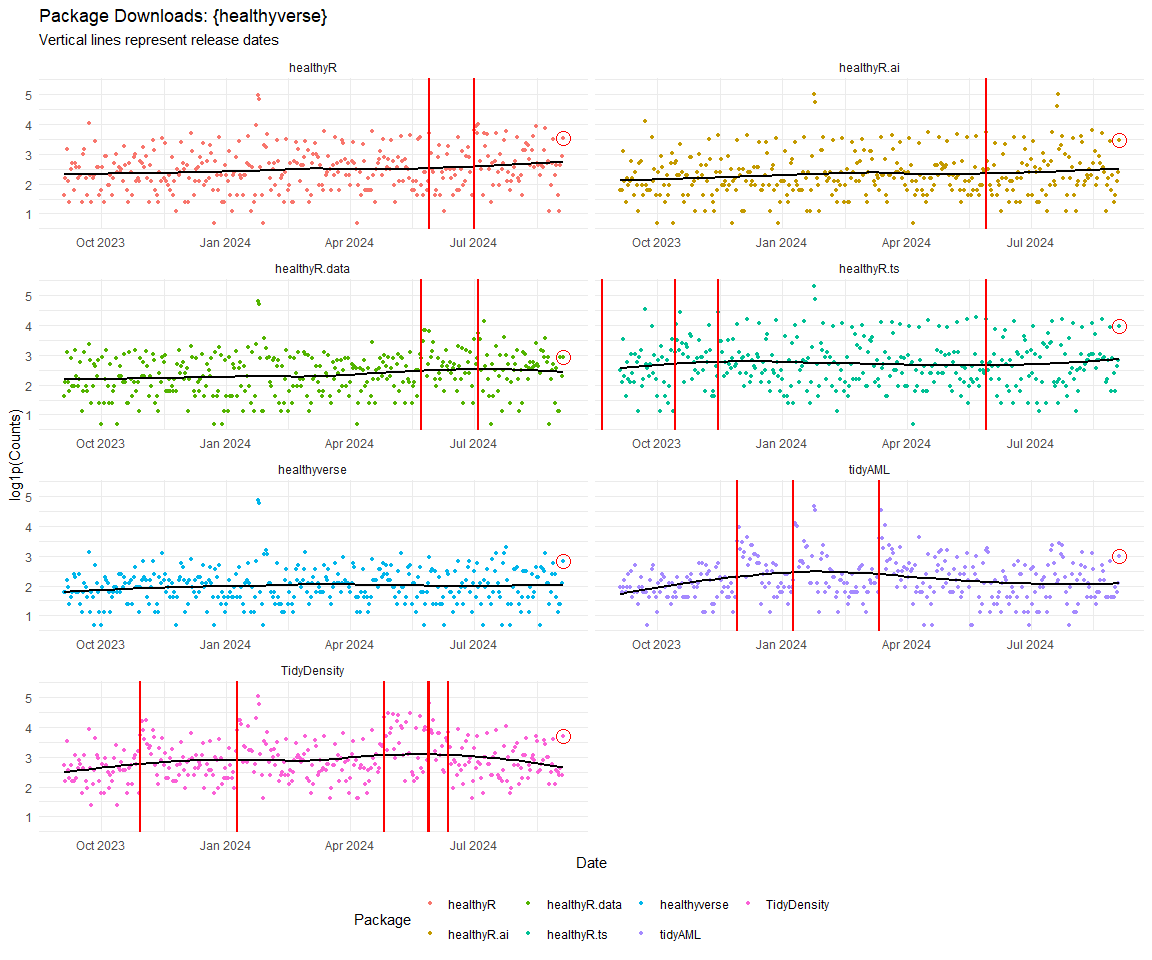
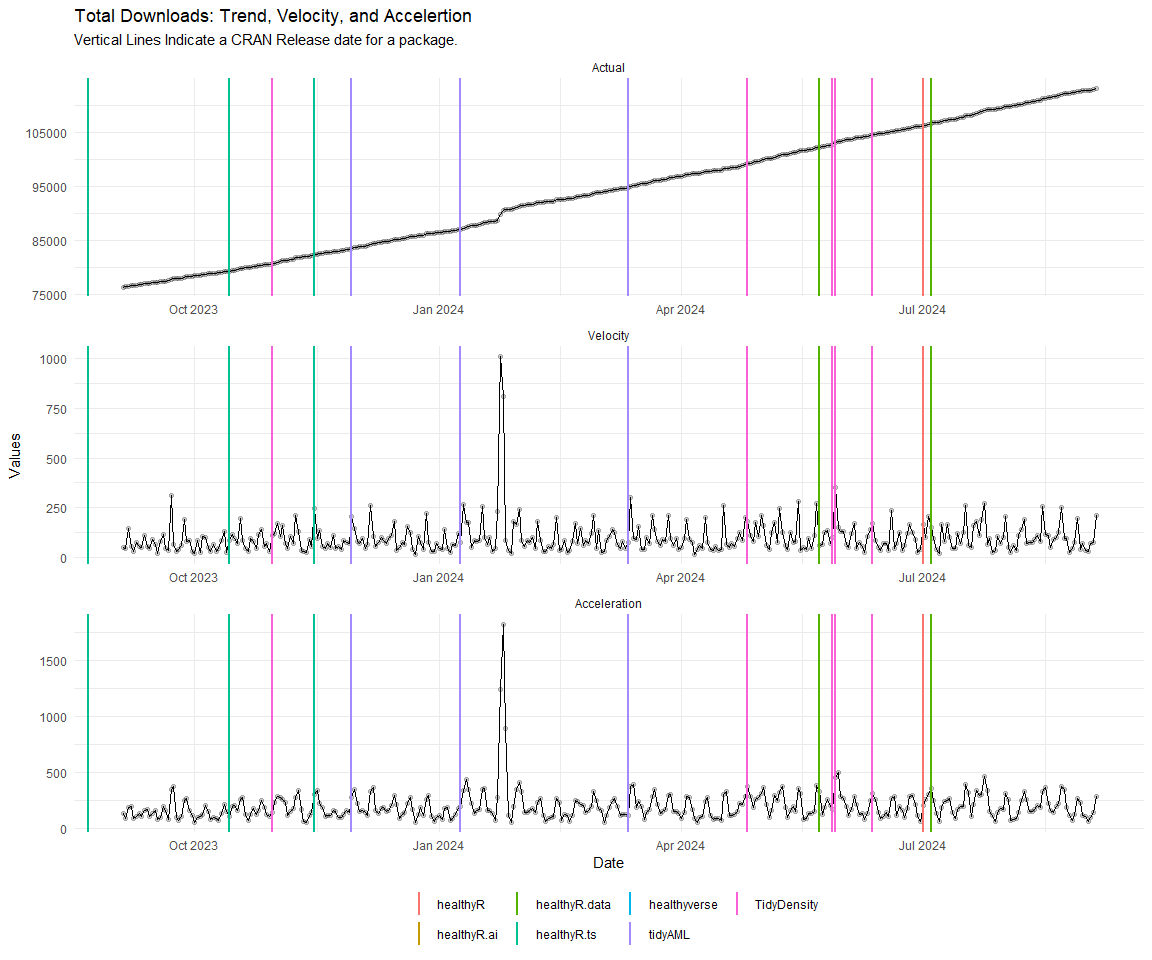
[[1]]
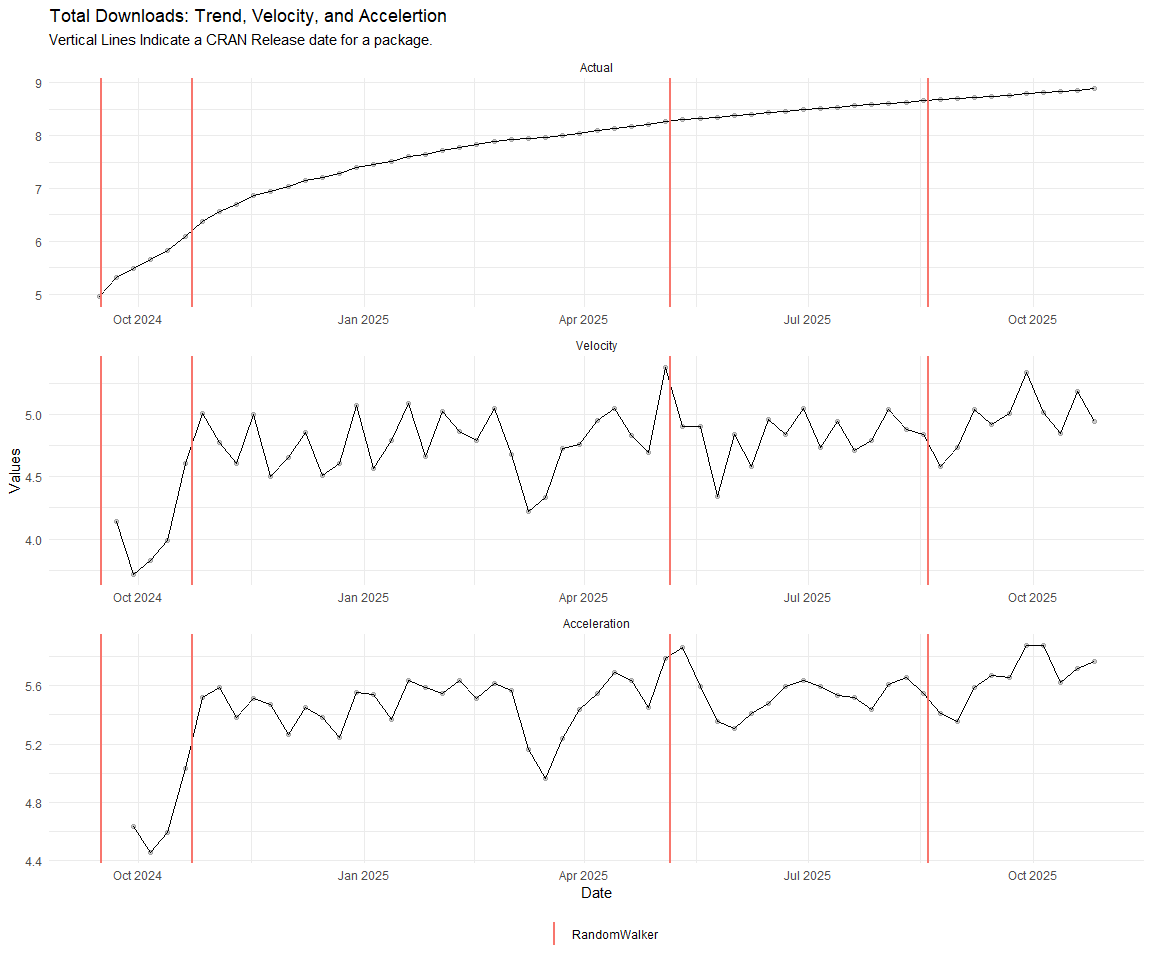
[[2]]
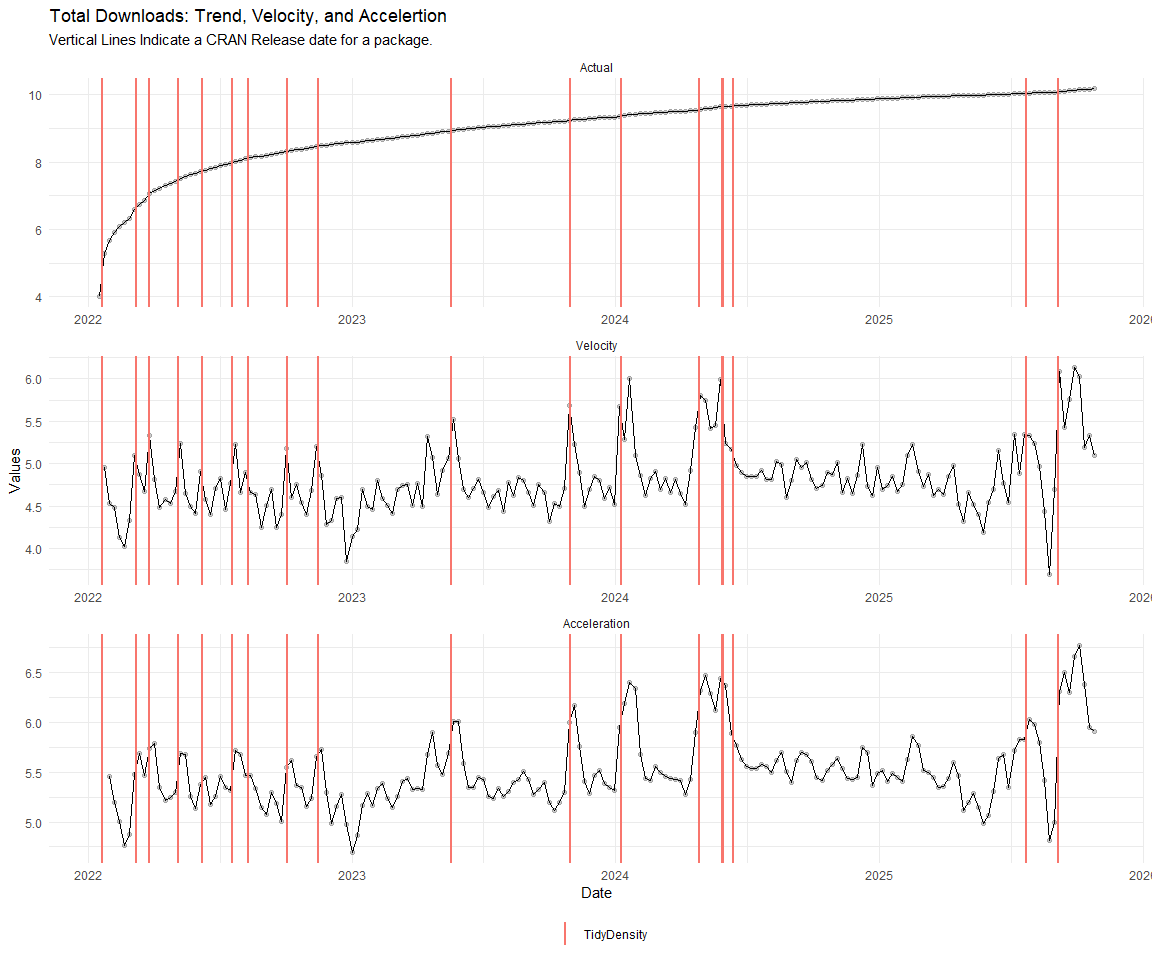
[[3]]
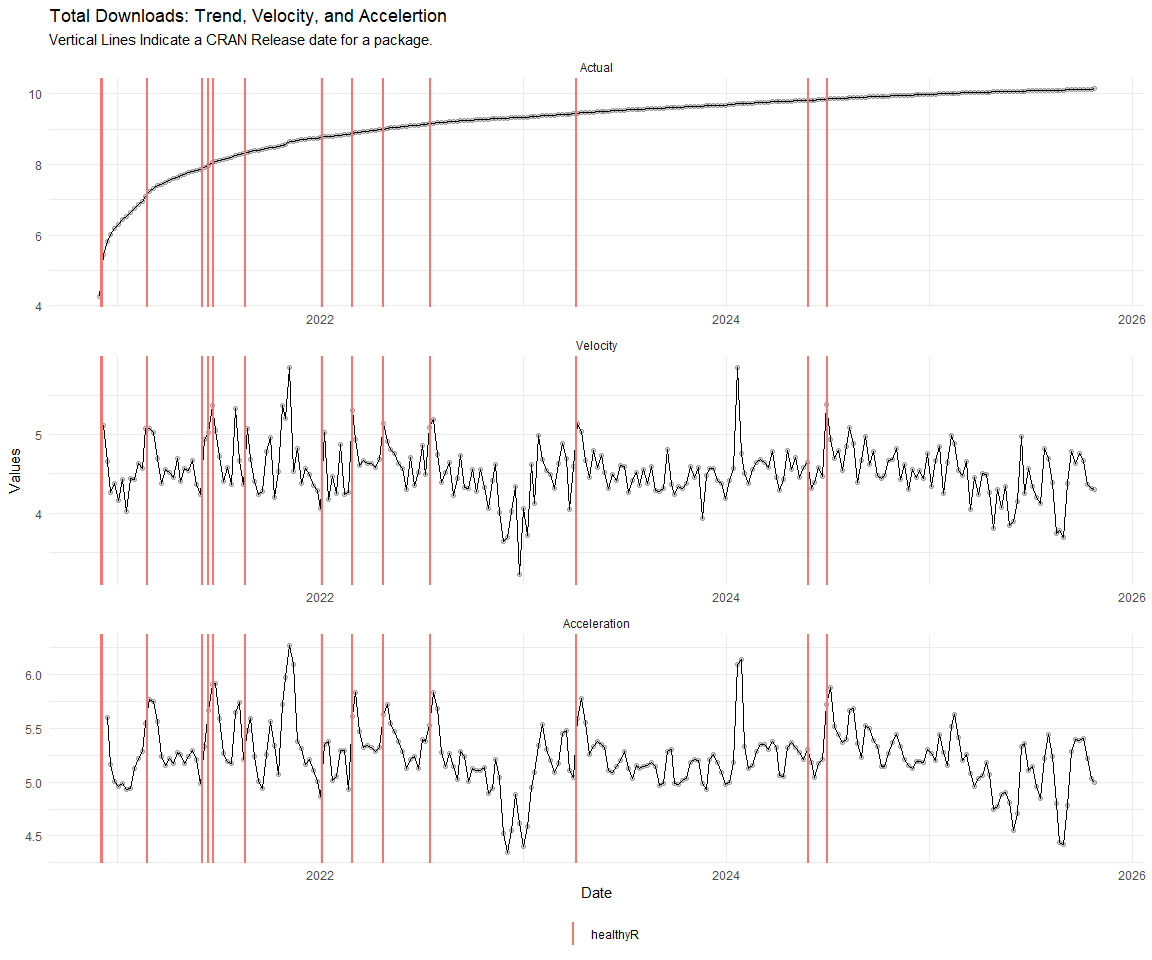
[[4]]
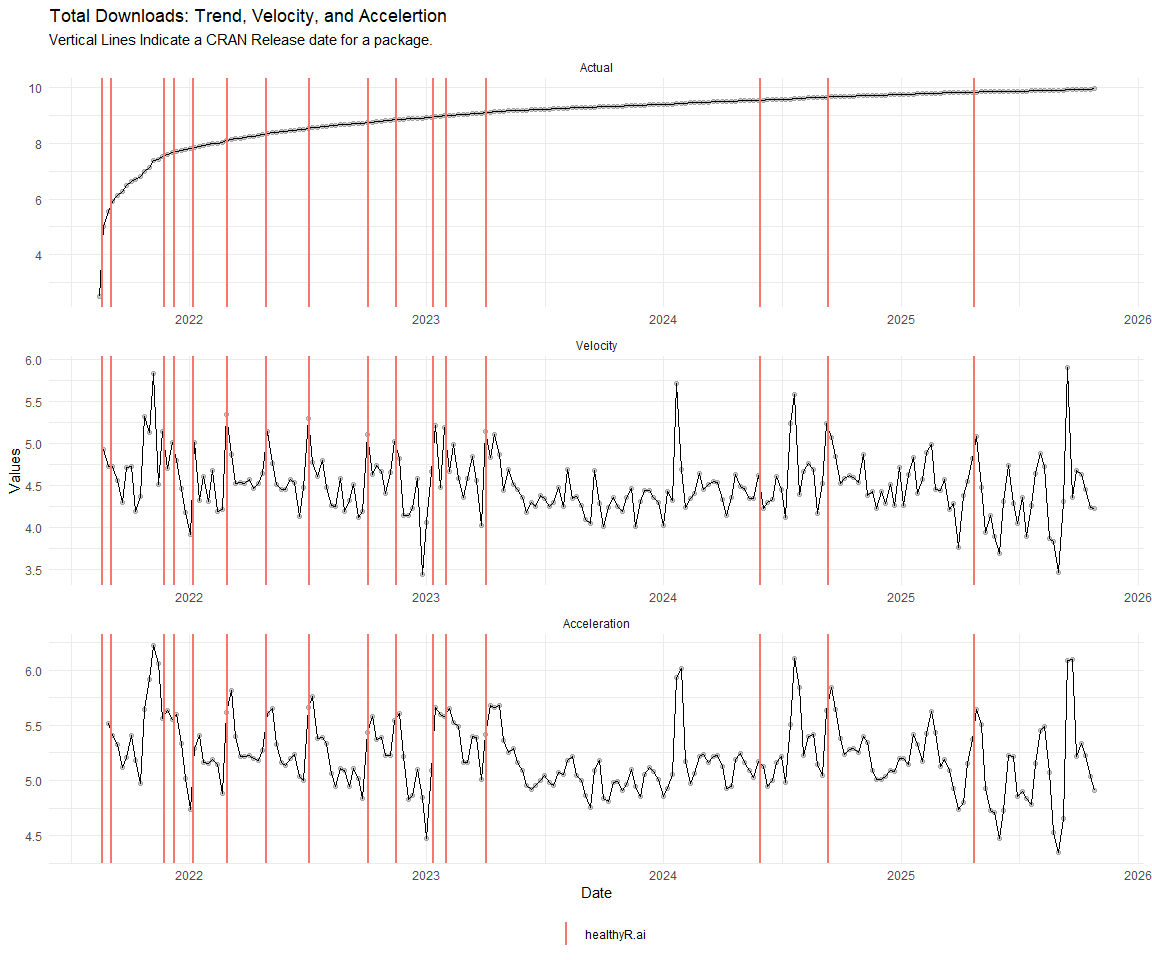
[[5]]
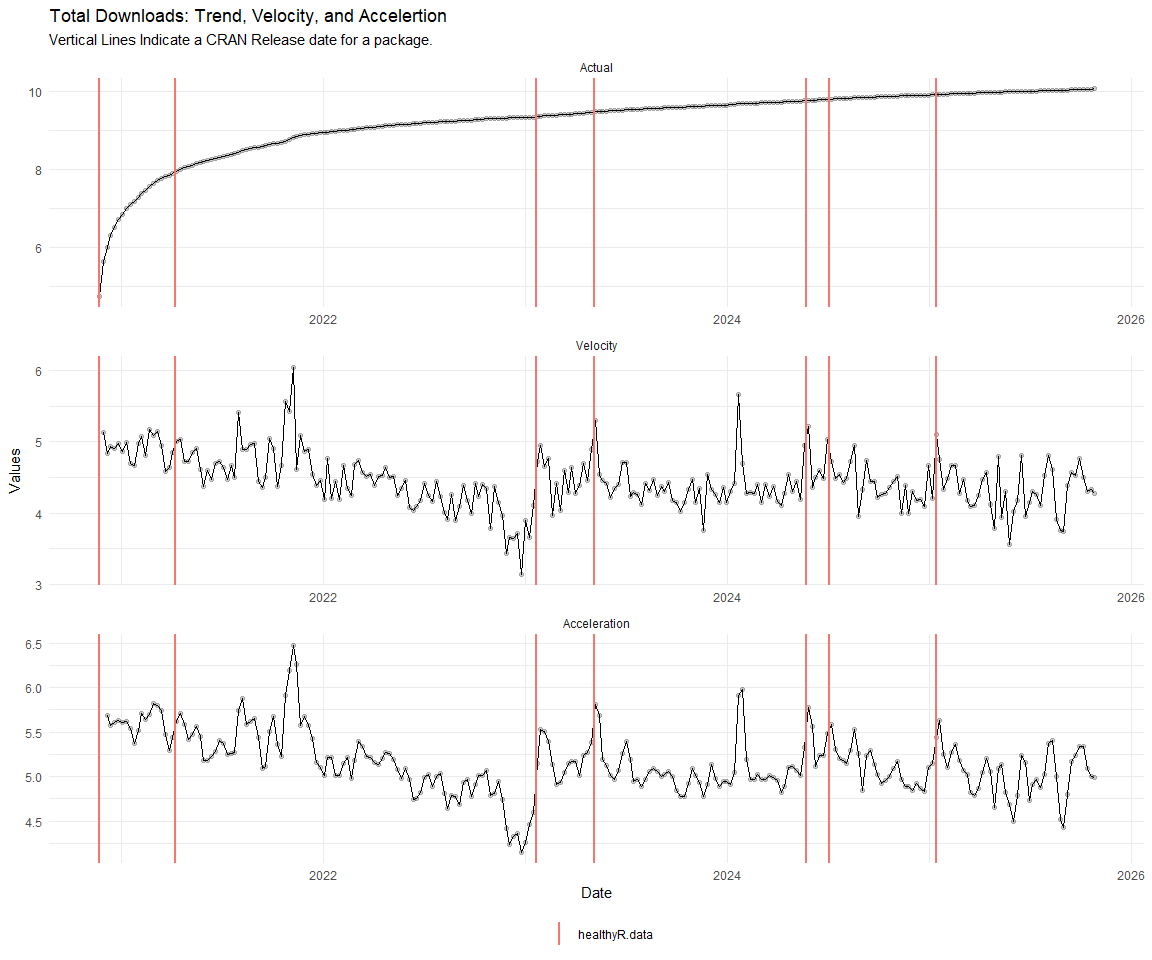
[[6]]
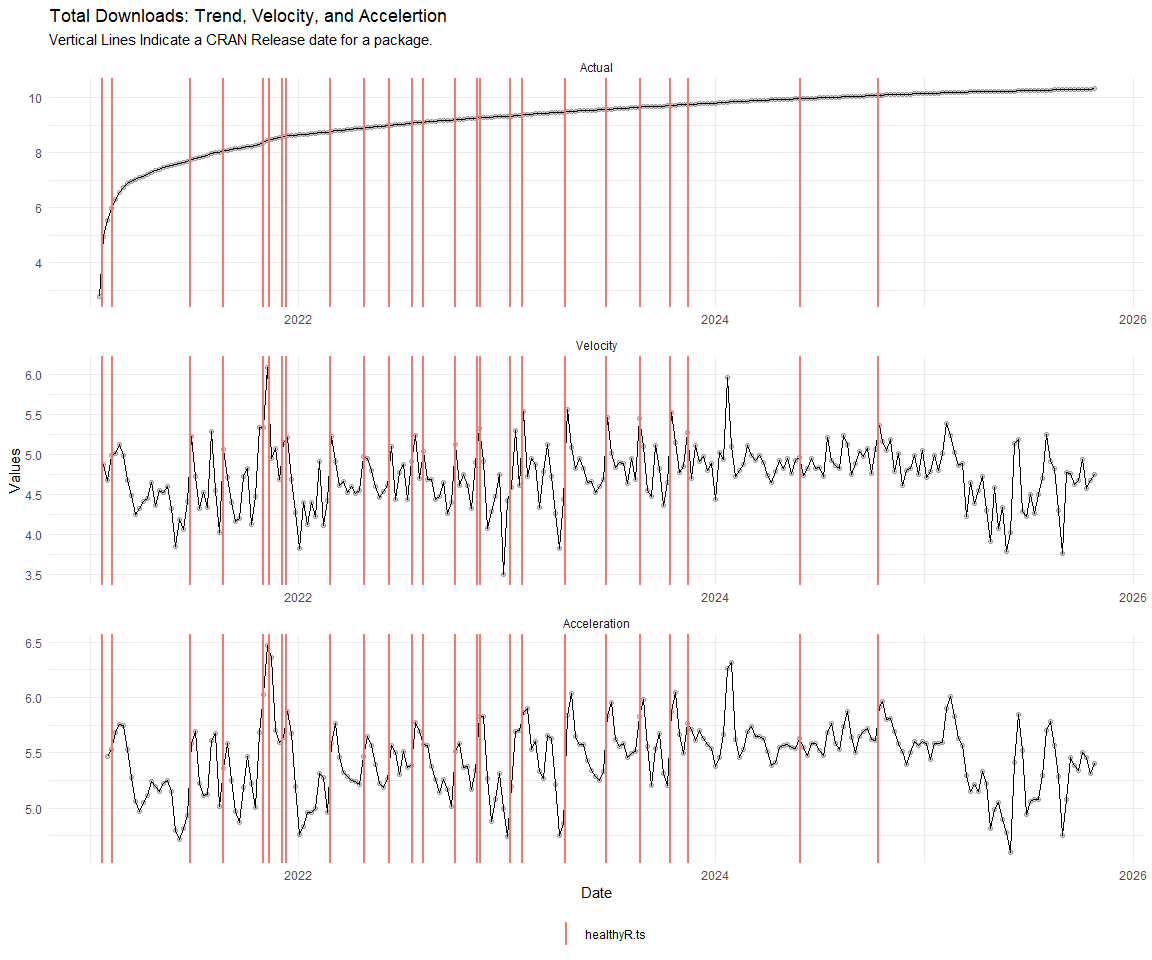
[[7]]
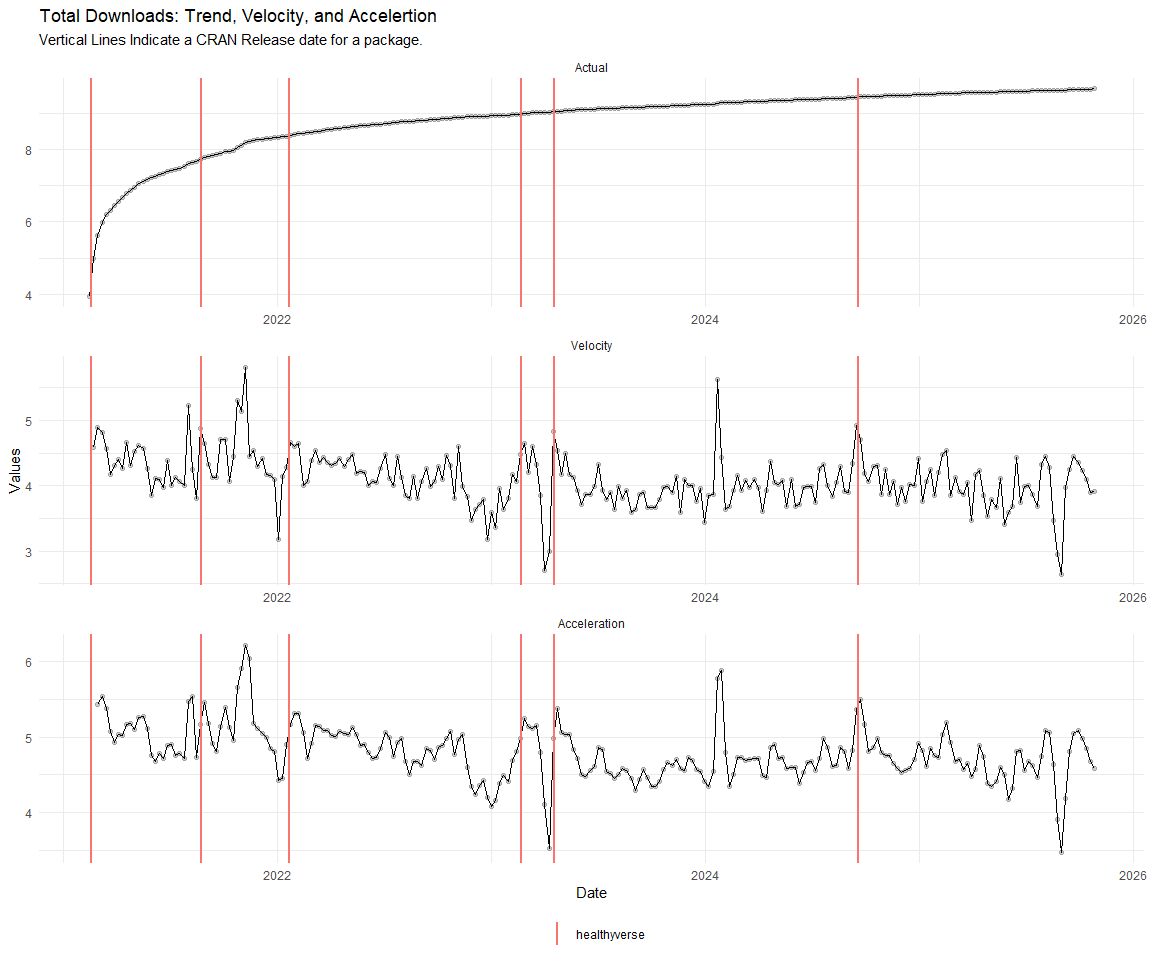
[[8]]
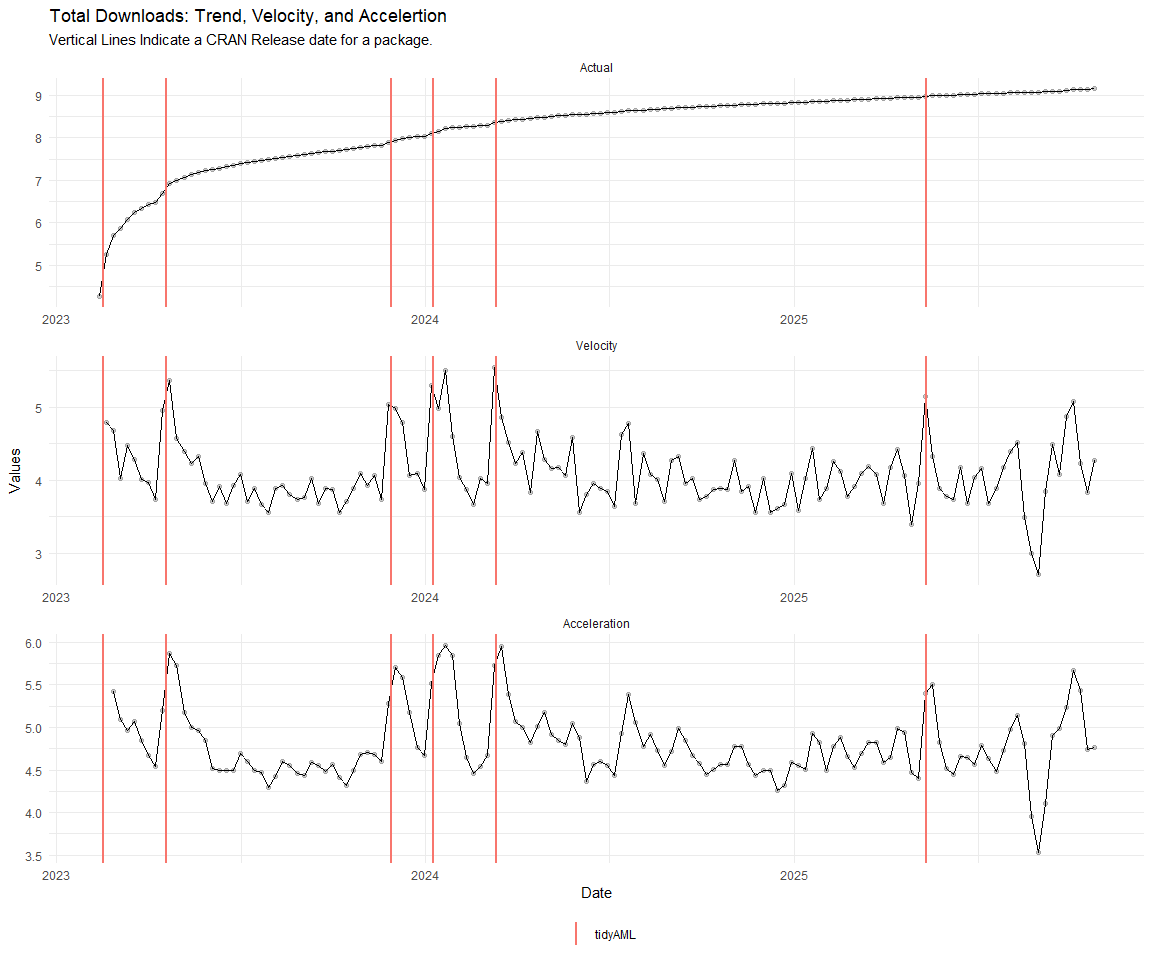
Now lets take a look at some time series decomposition graphs.
[[1]]
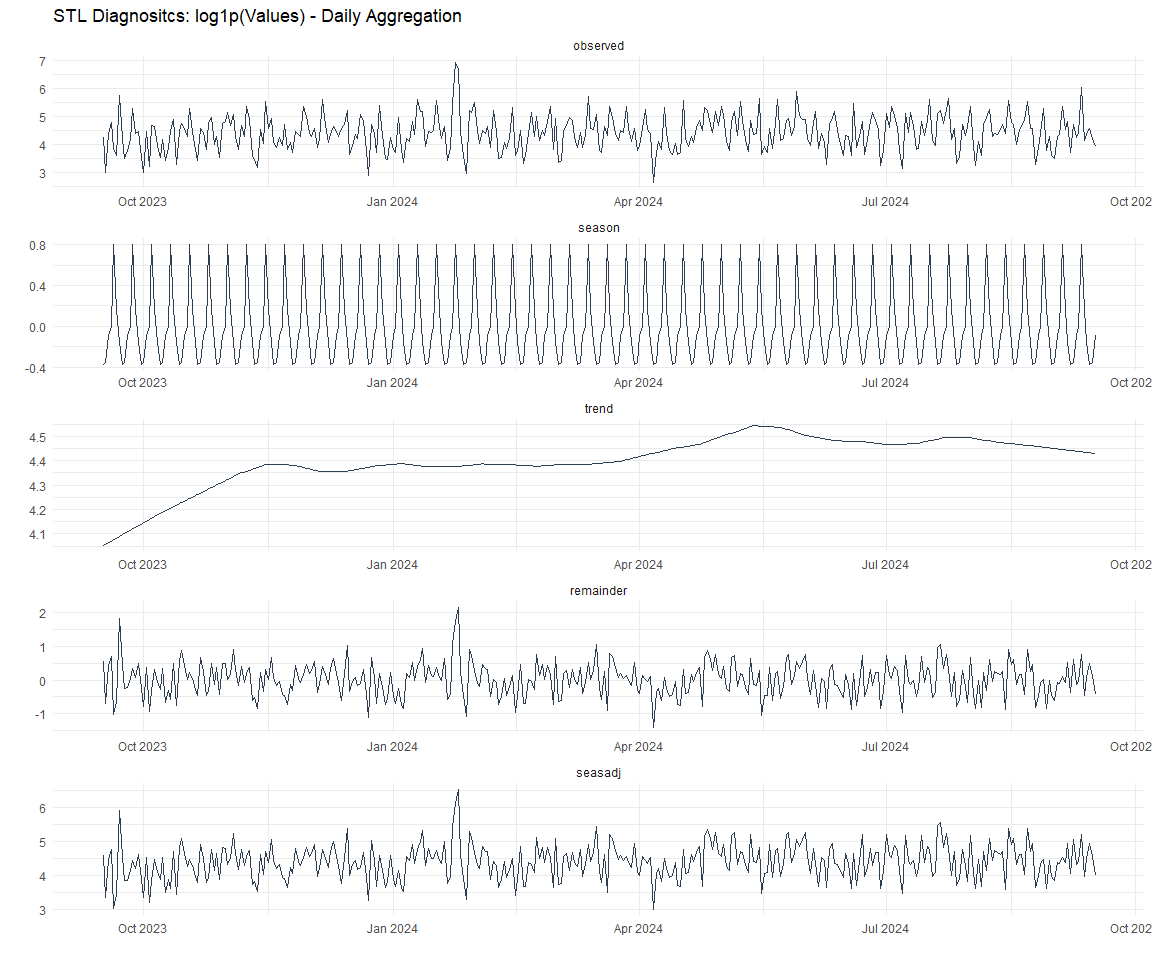
[[2]]
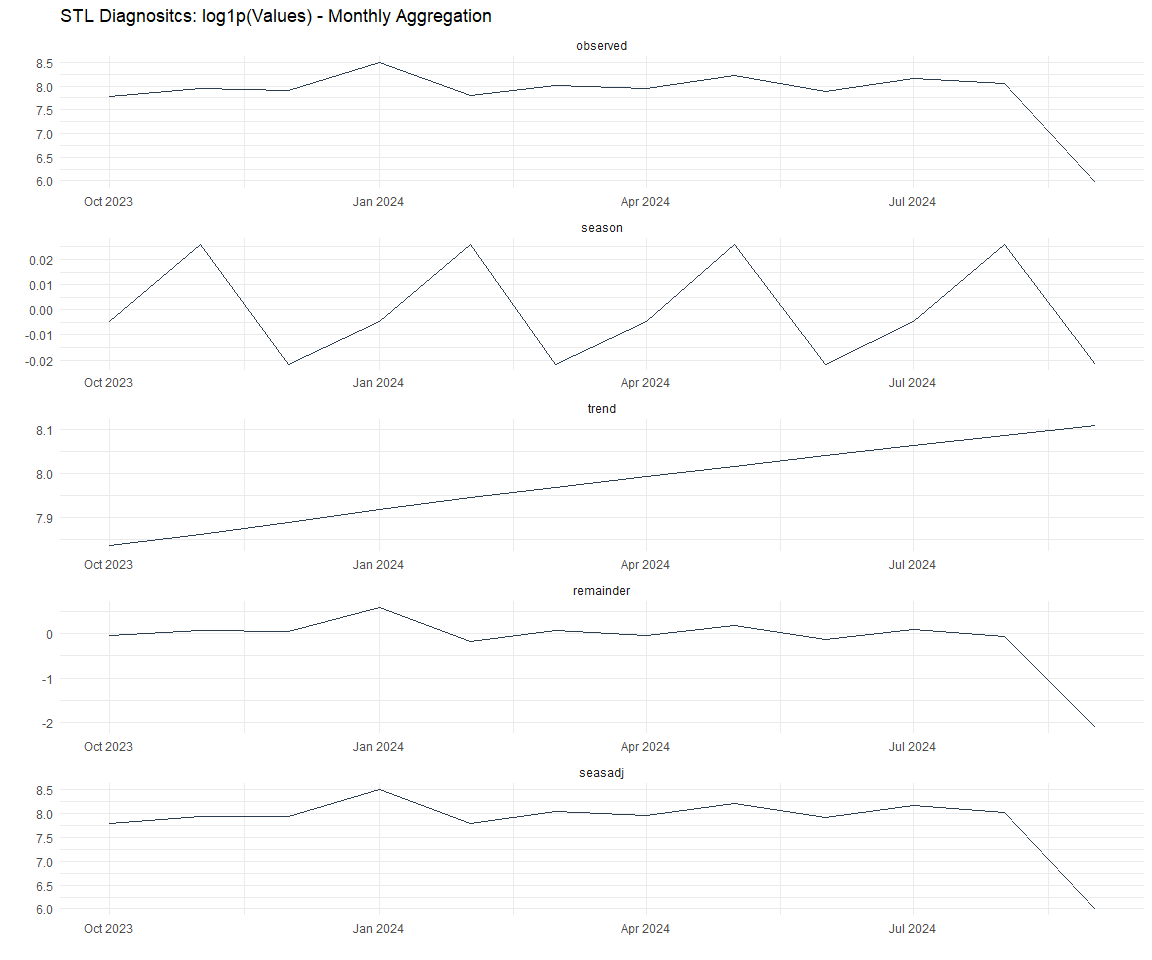
[[3]]
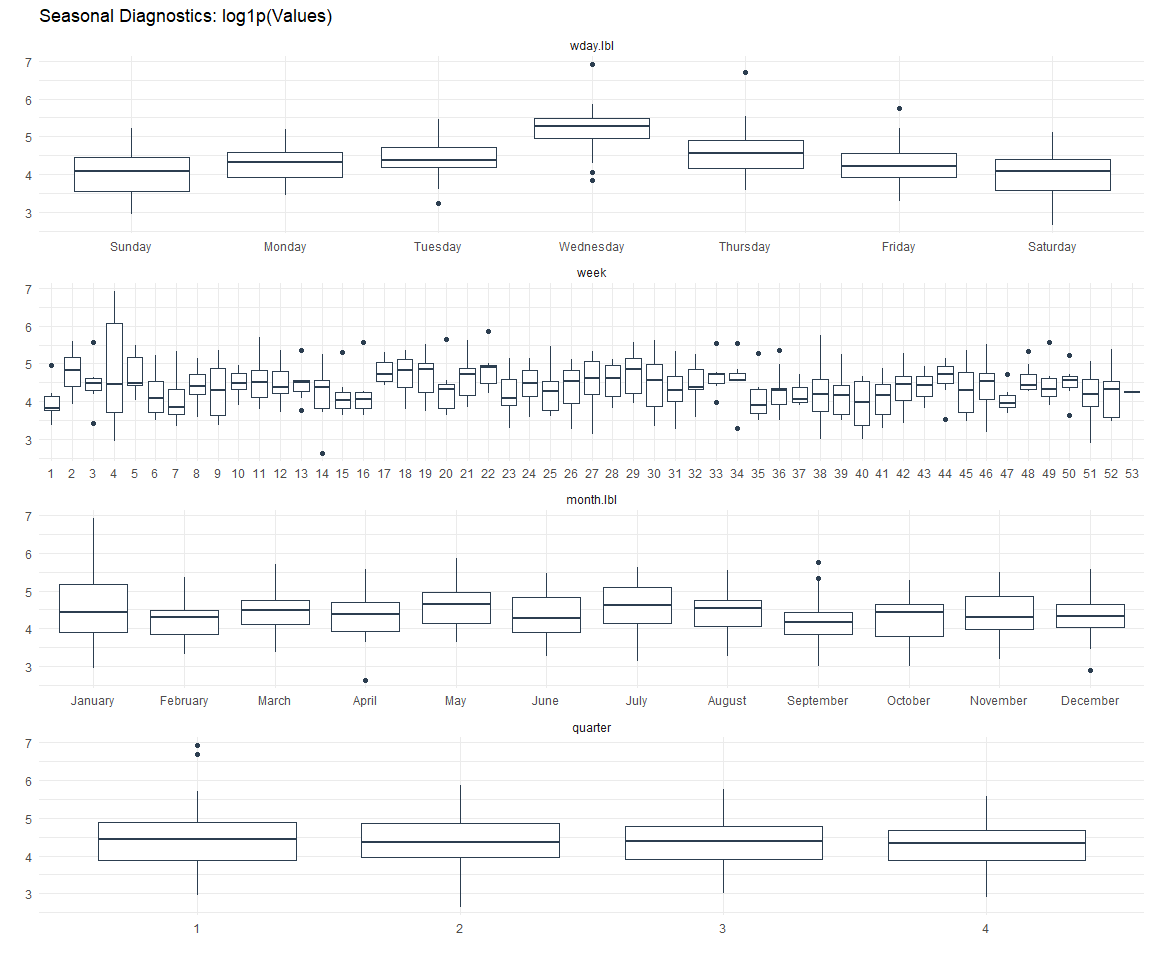
[[4]]

[[5]]
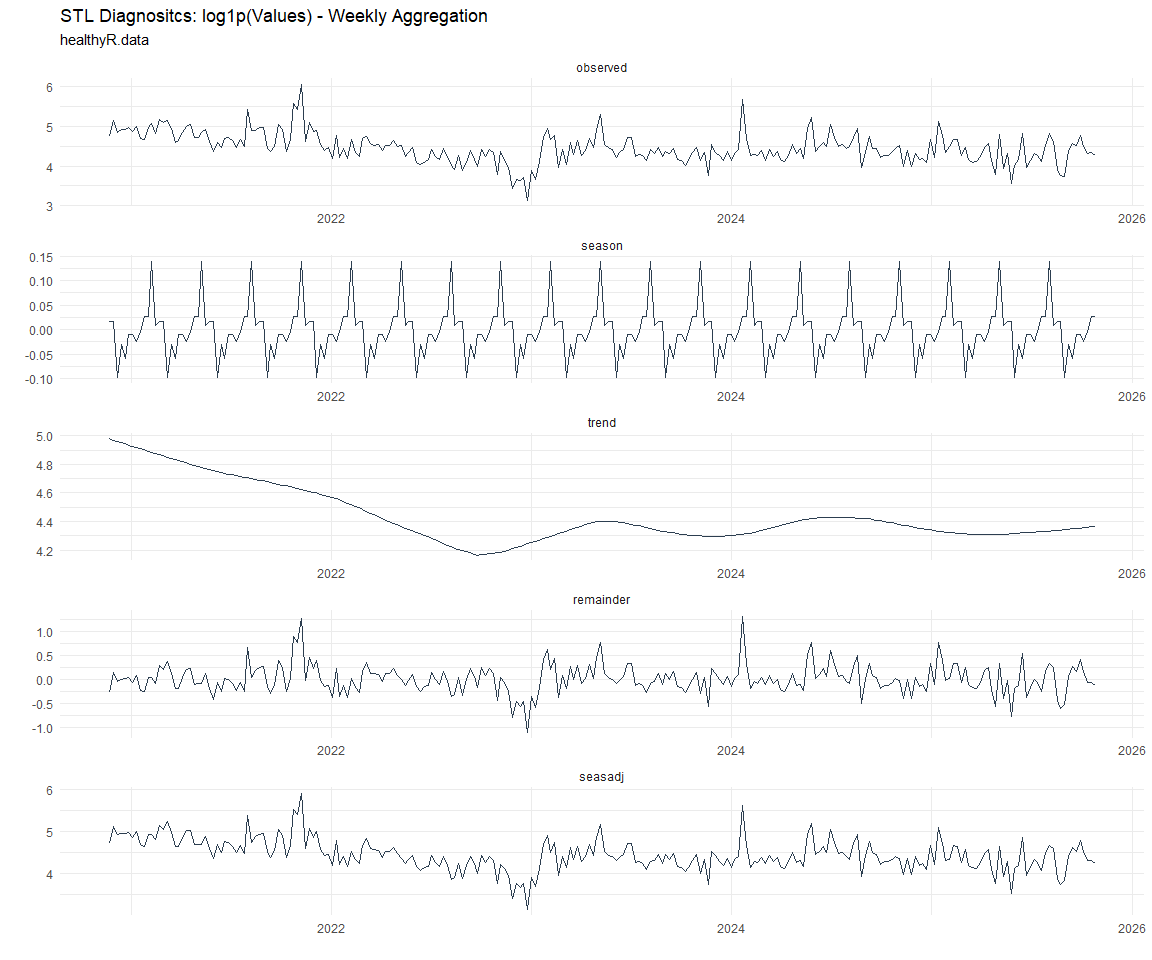
[[6]]
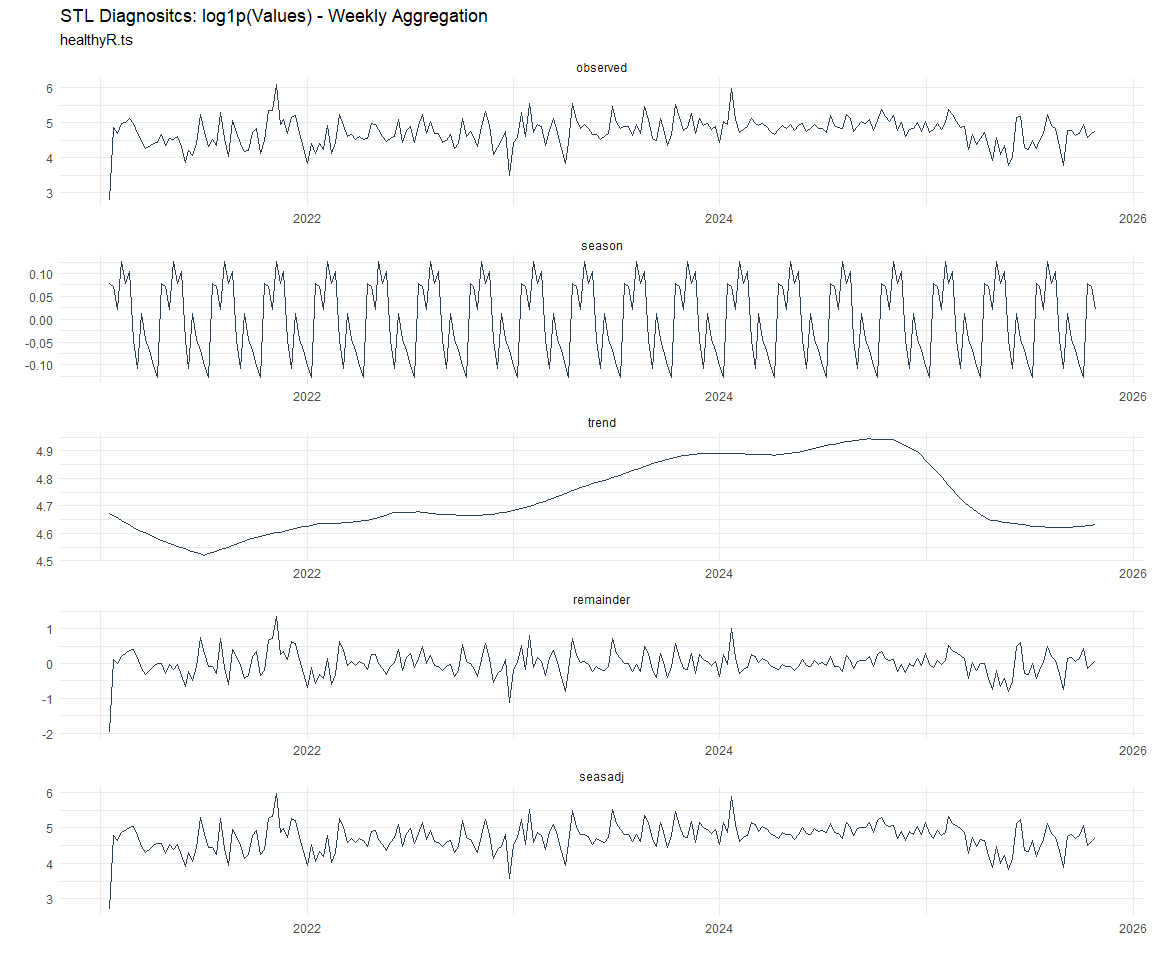
[[7]]
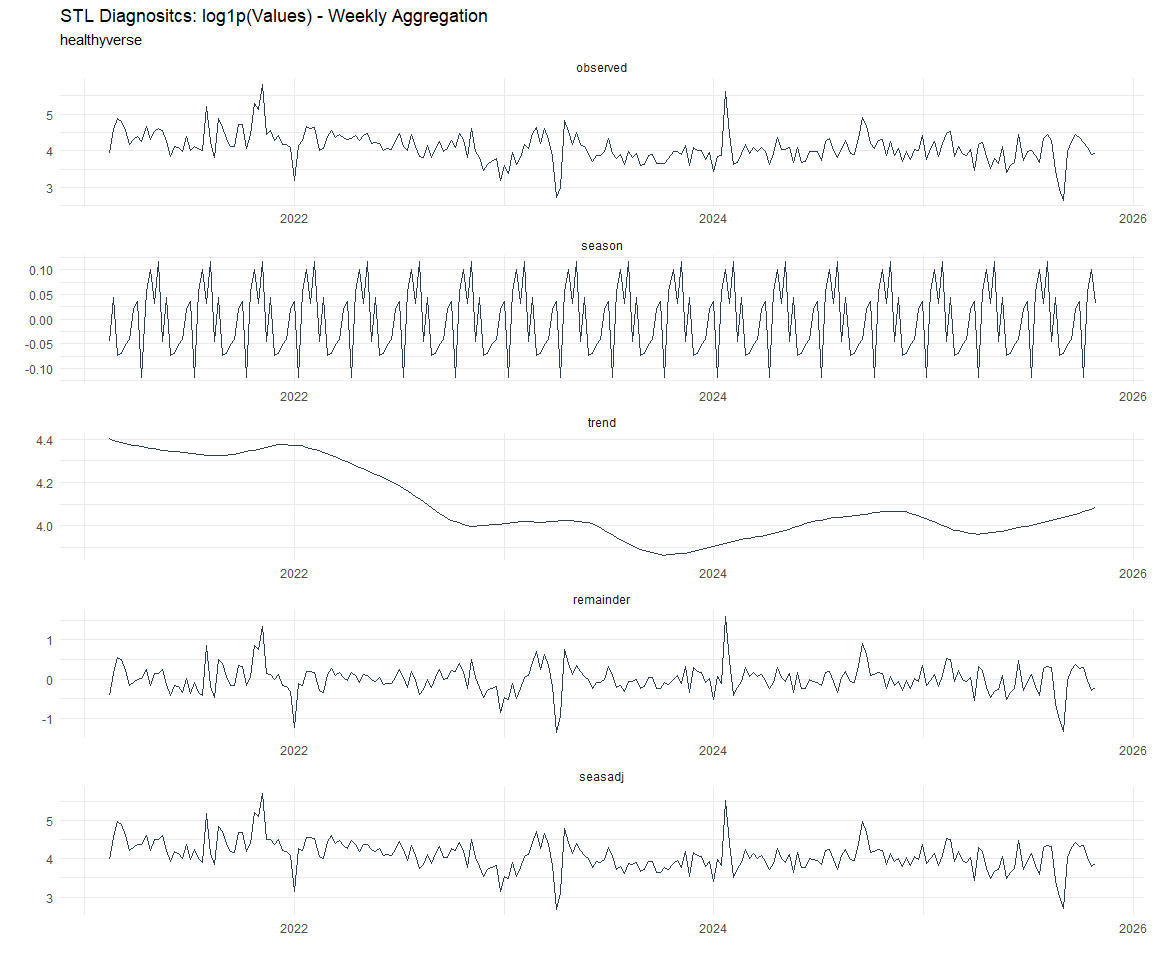
[[8]]
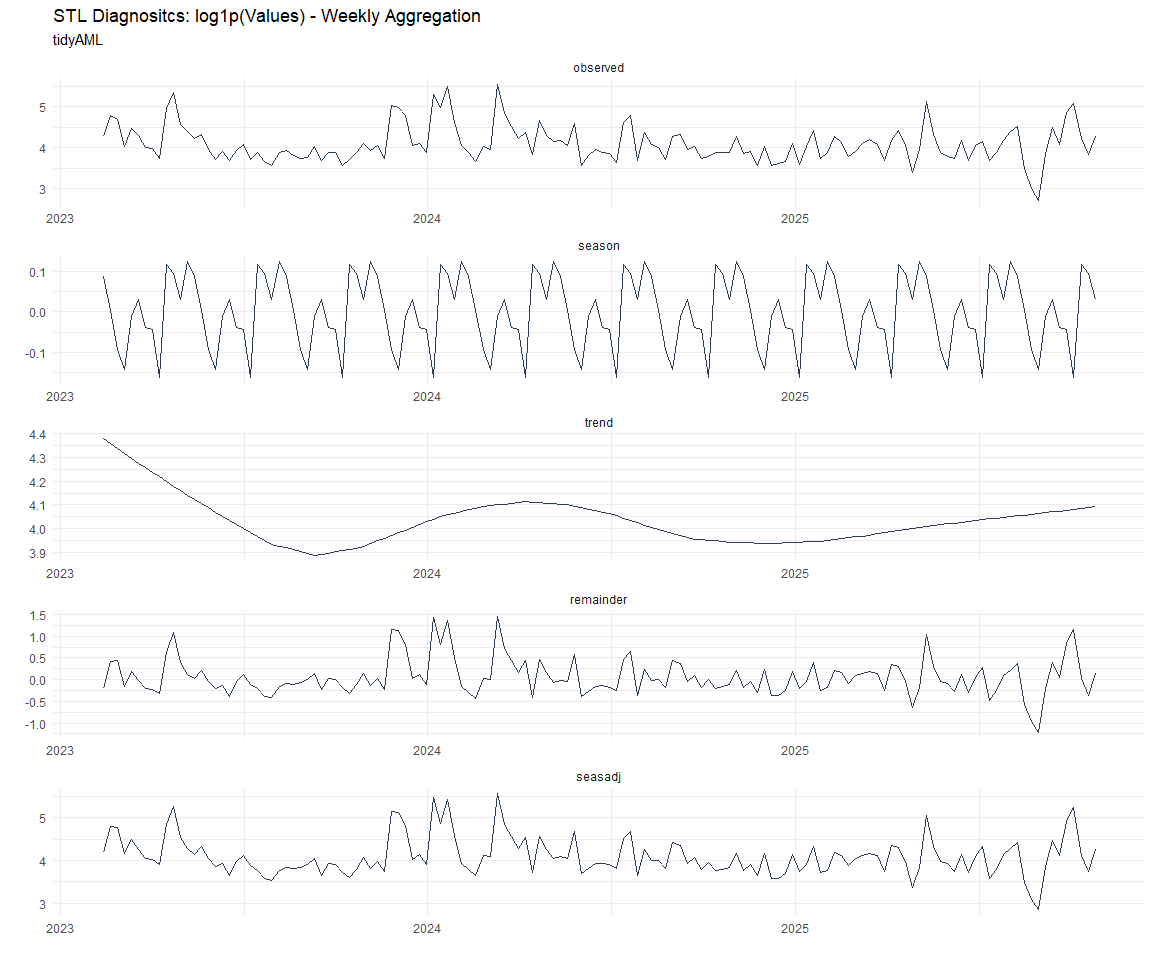
[[1]]
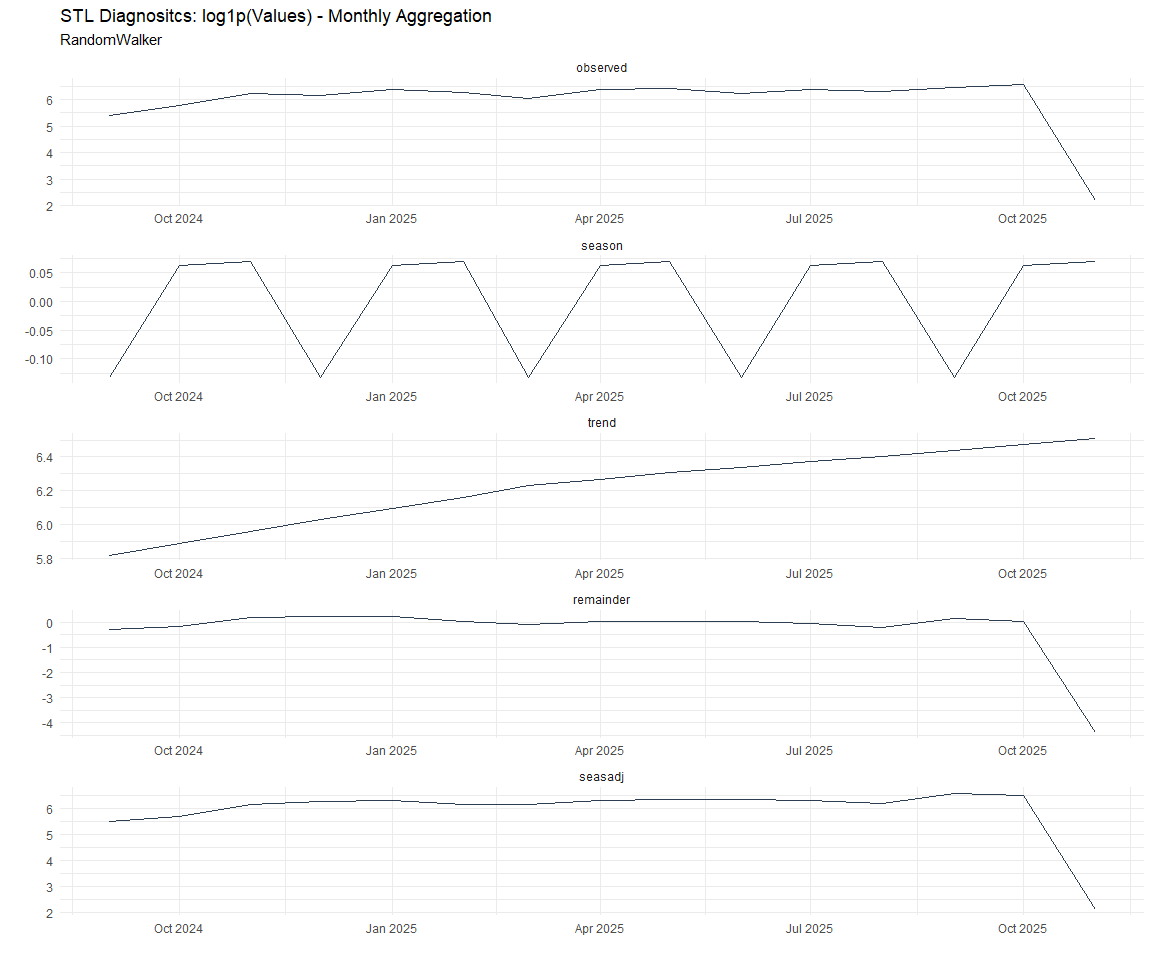
[[2]]
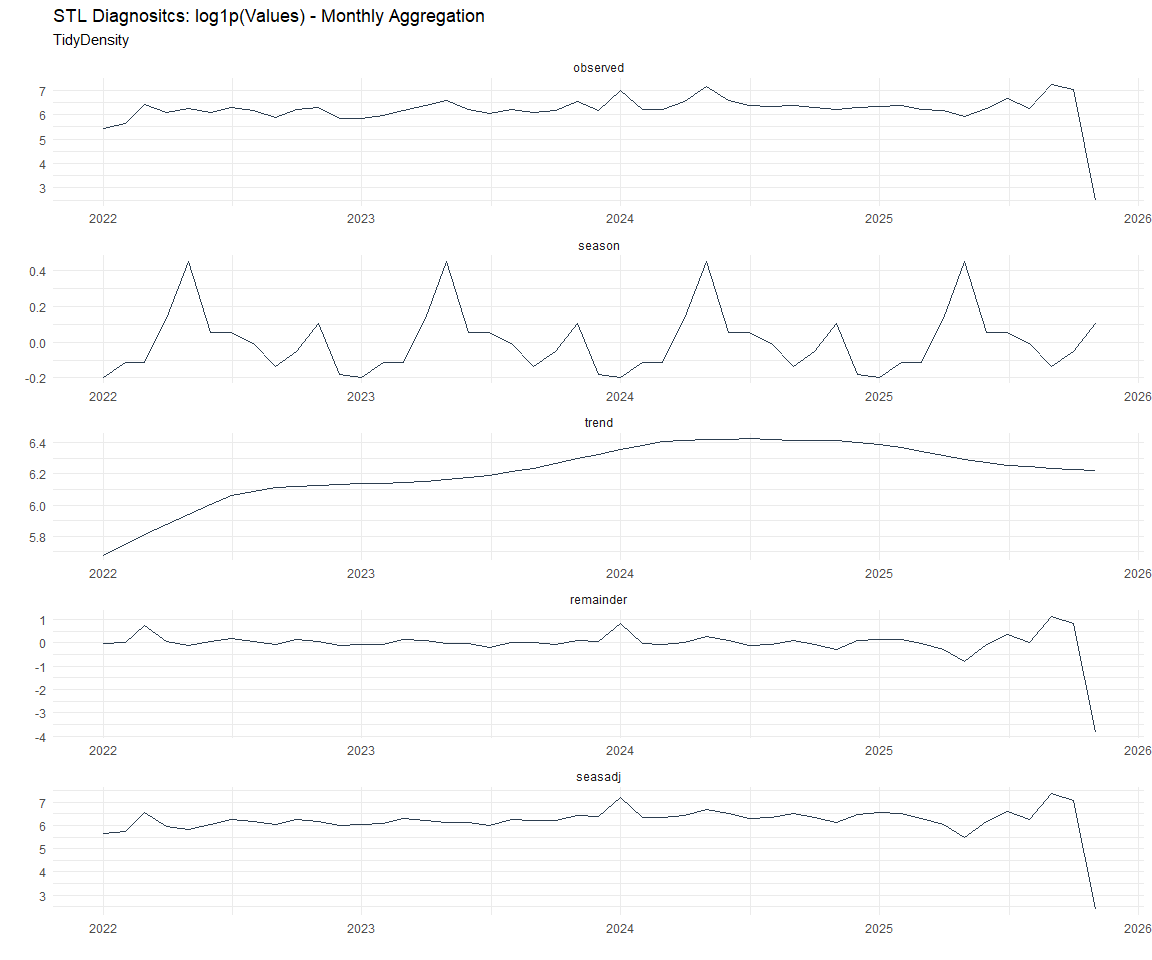
[[3]]
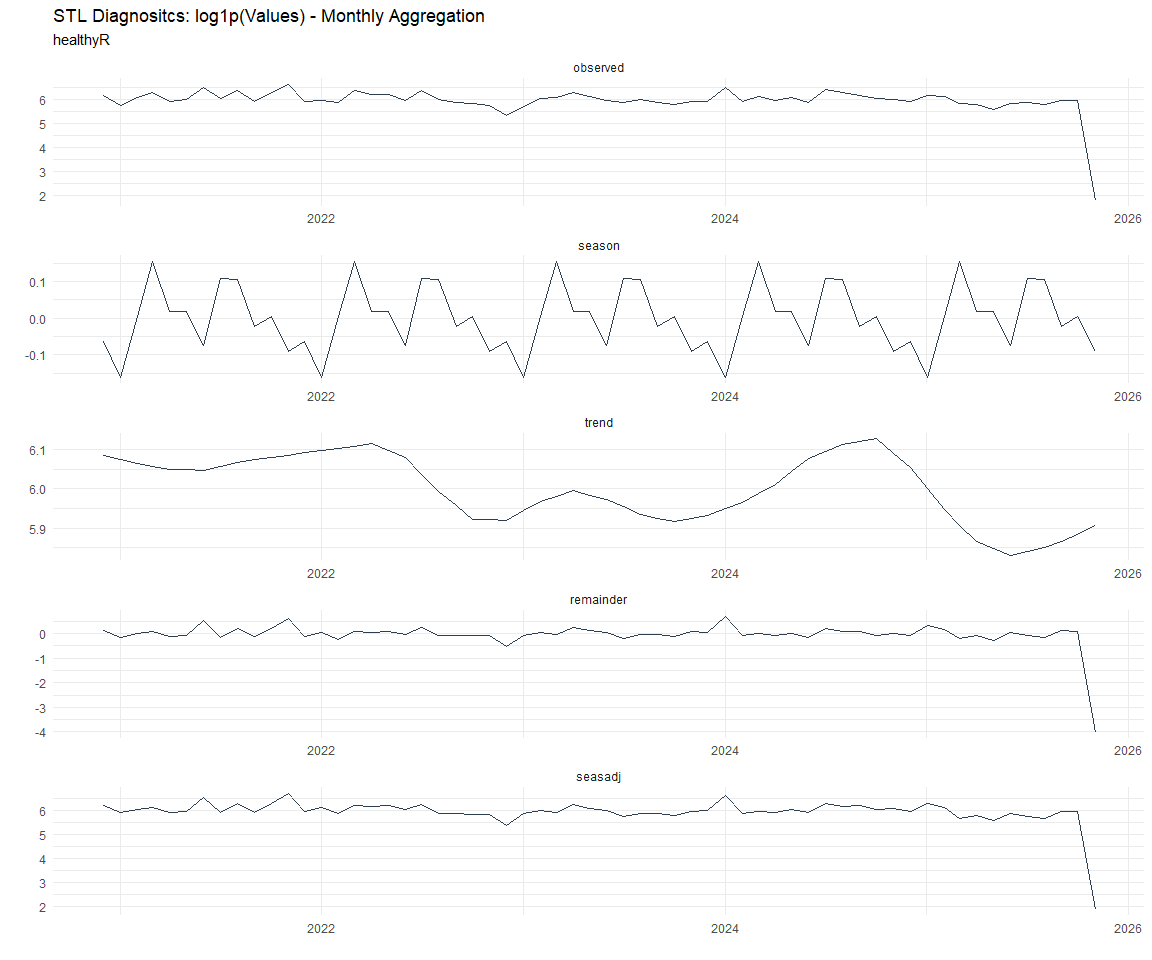
[[4]]
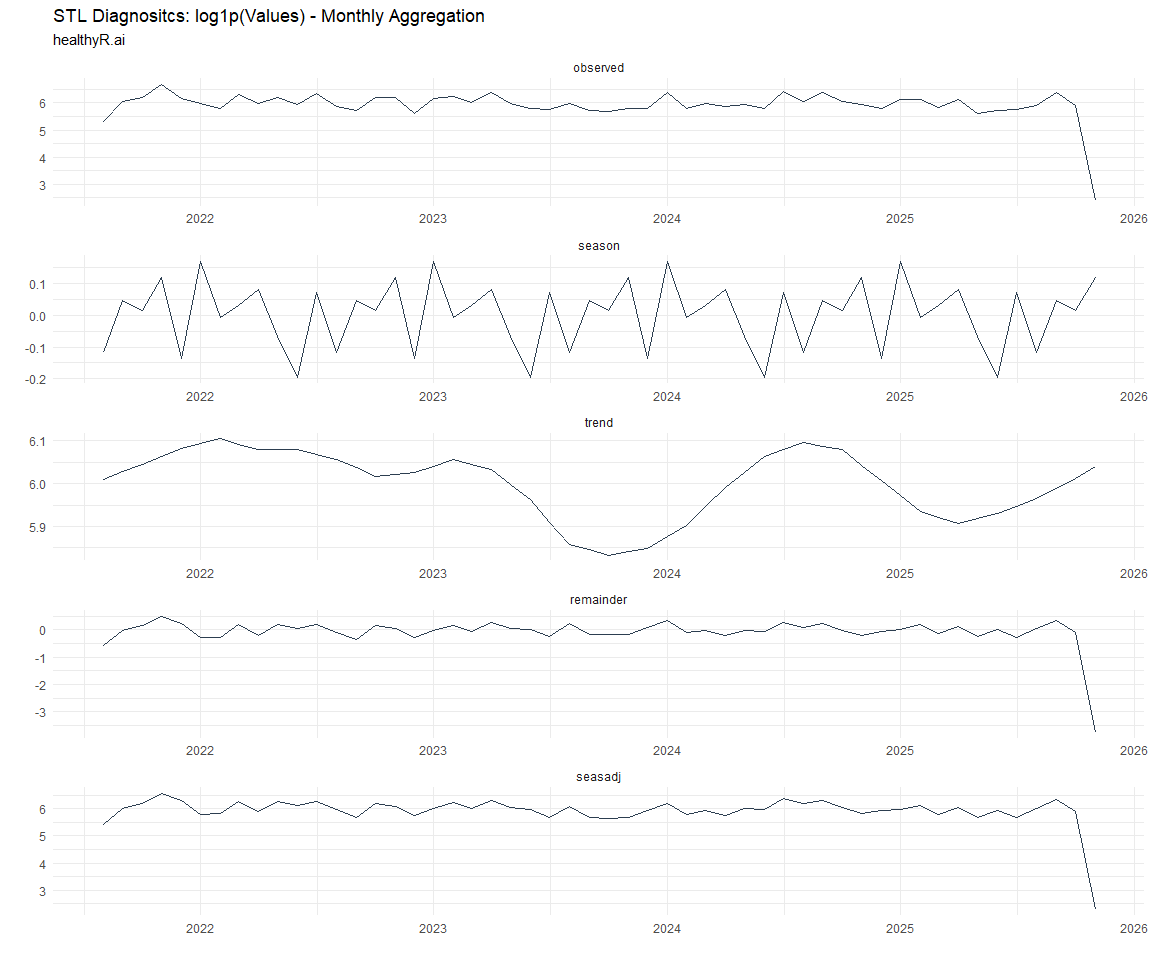
[[5]]
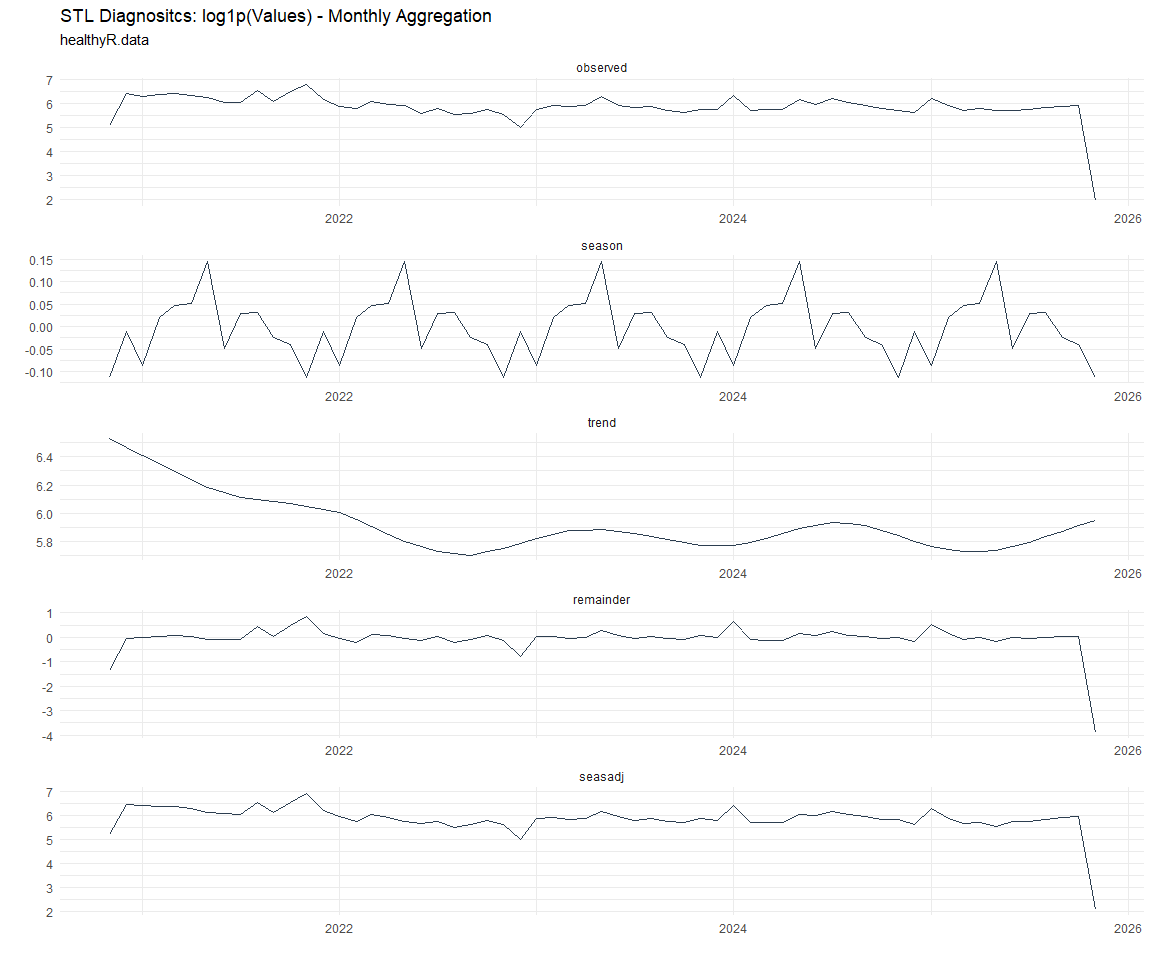
[[6]]
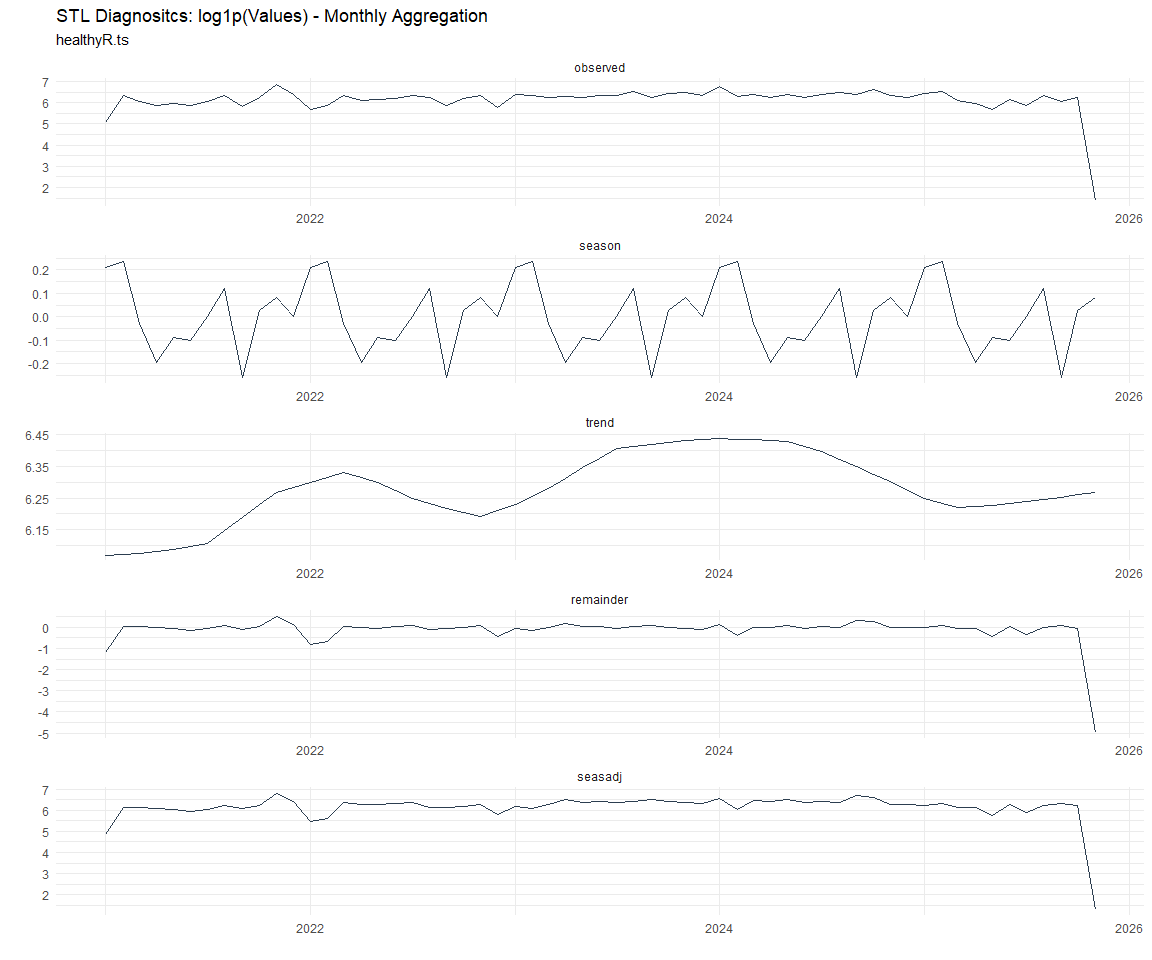
[[7]]
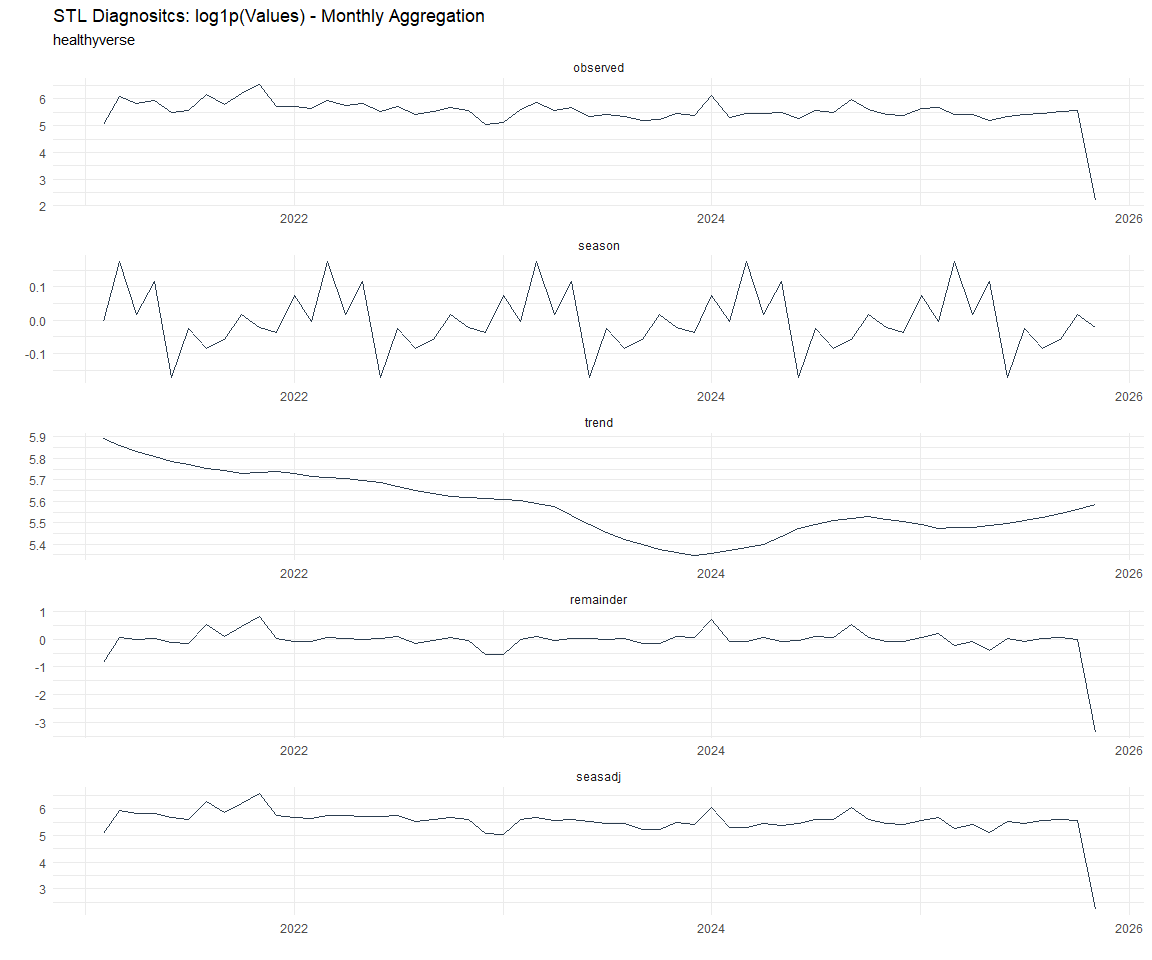
[[8]]
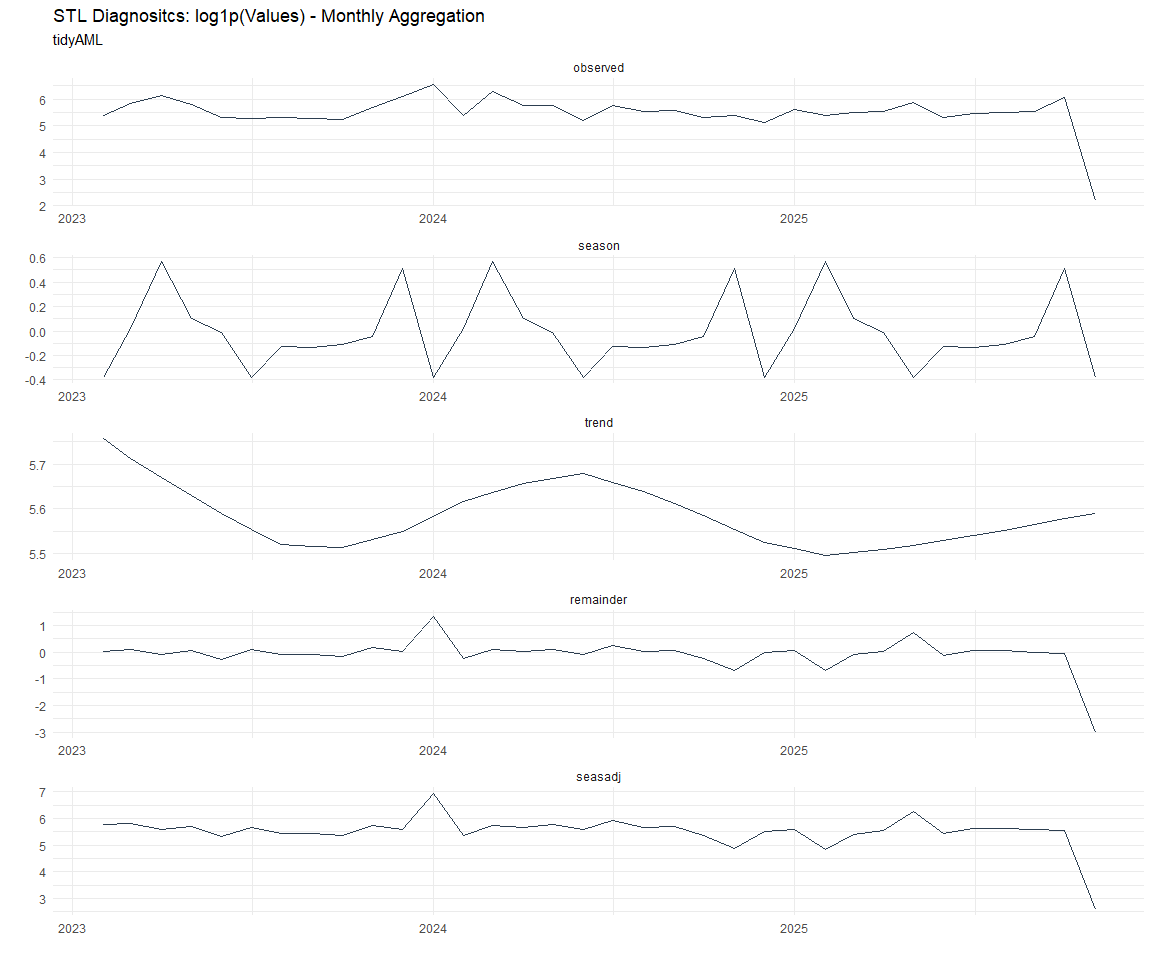
Seasonal Diagnostics:
[[1]]
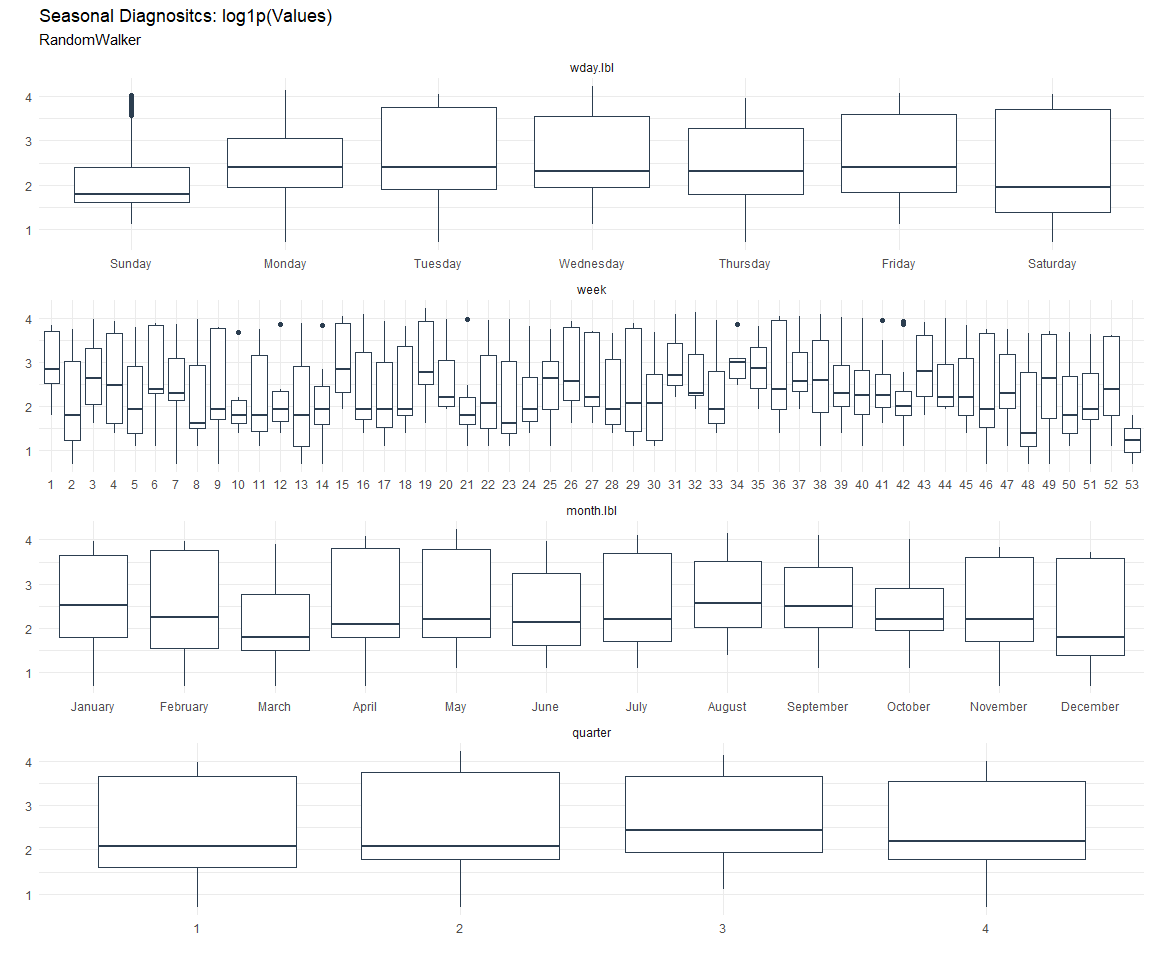
[[2]]
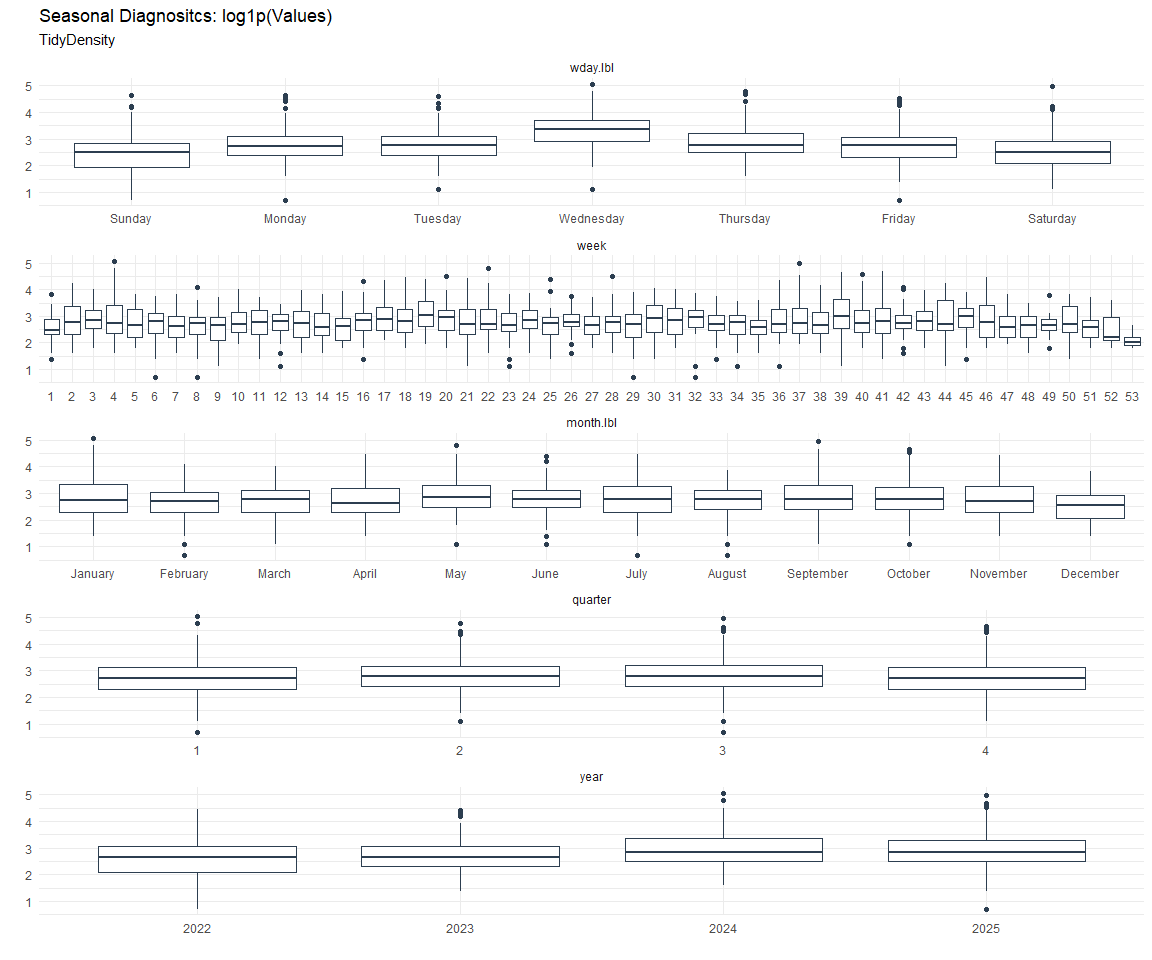
[[3]]
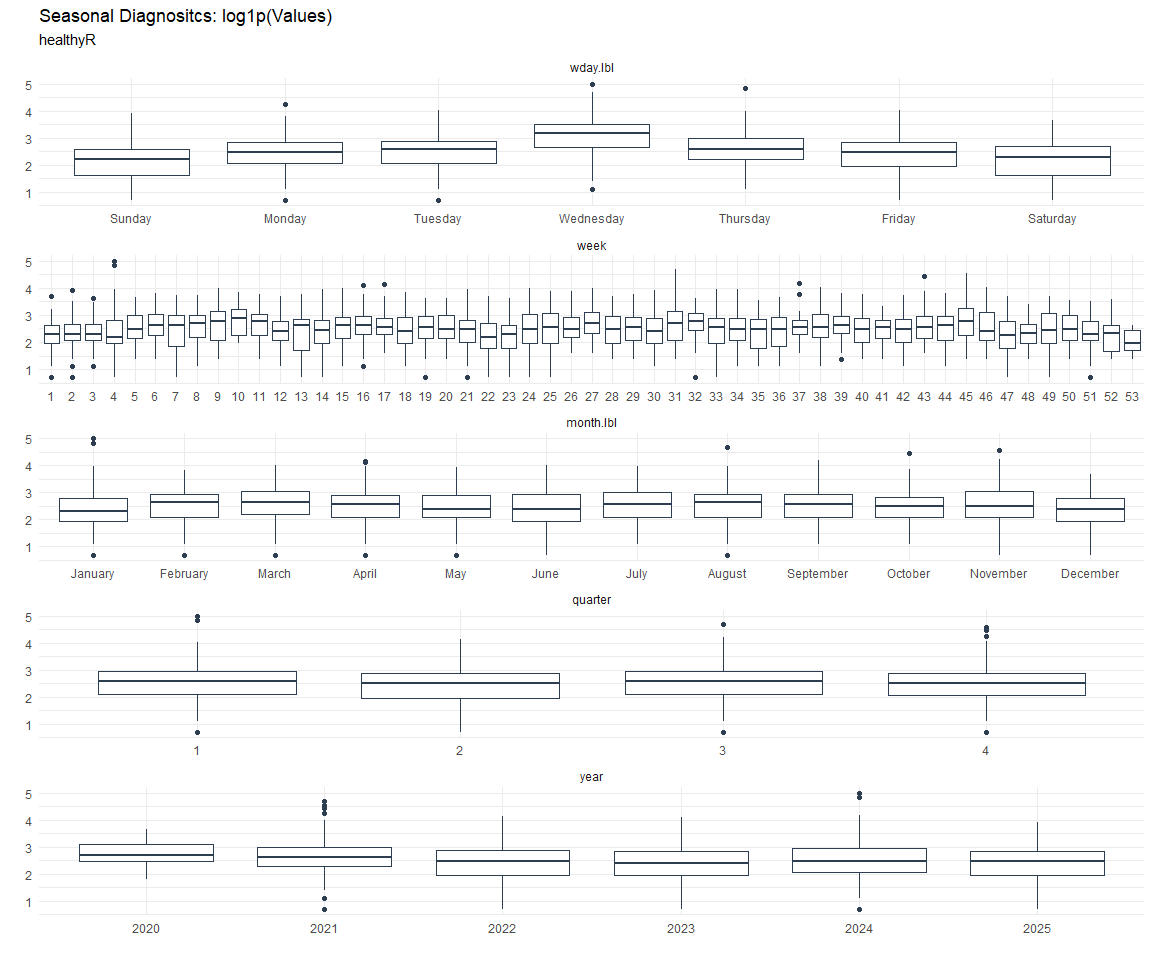
[[4]]
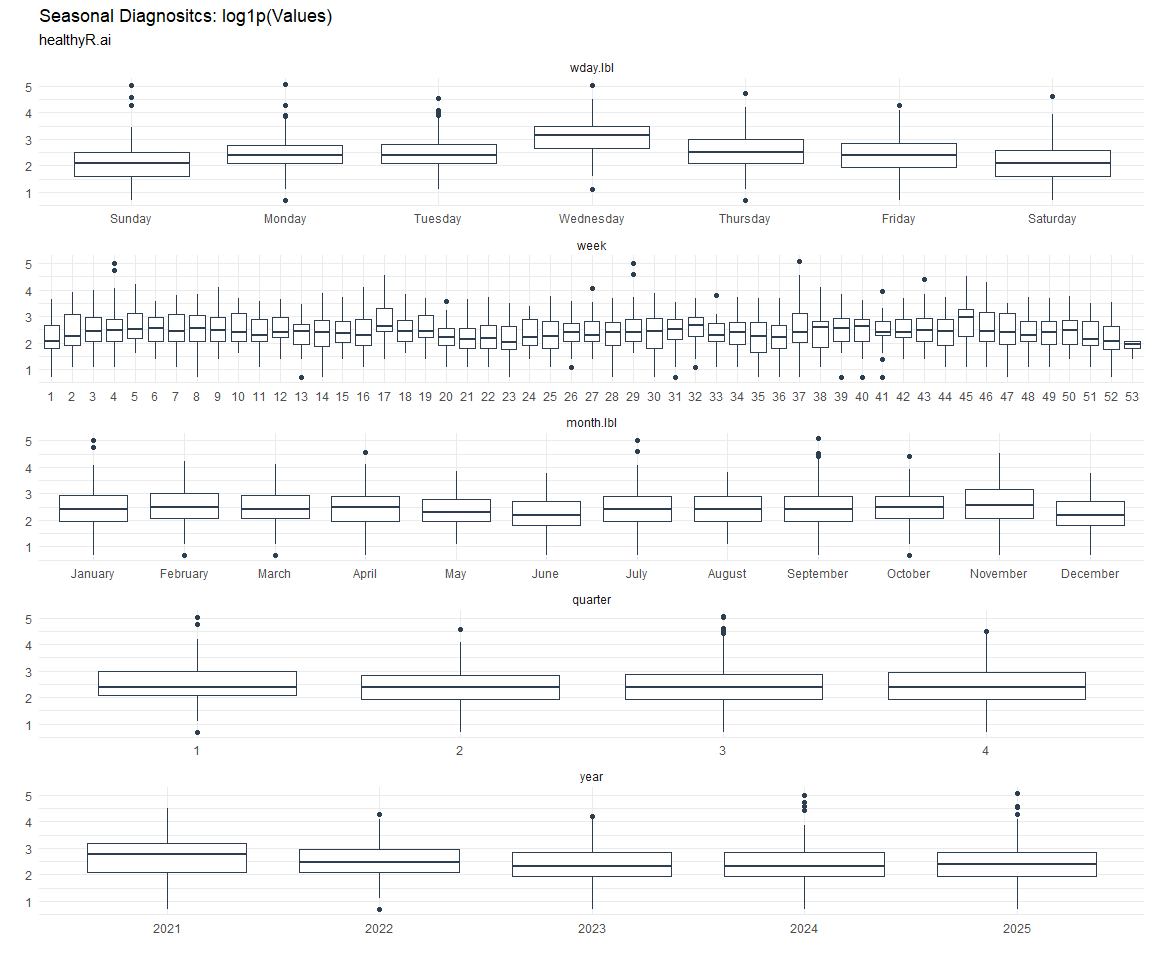
[[5]]
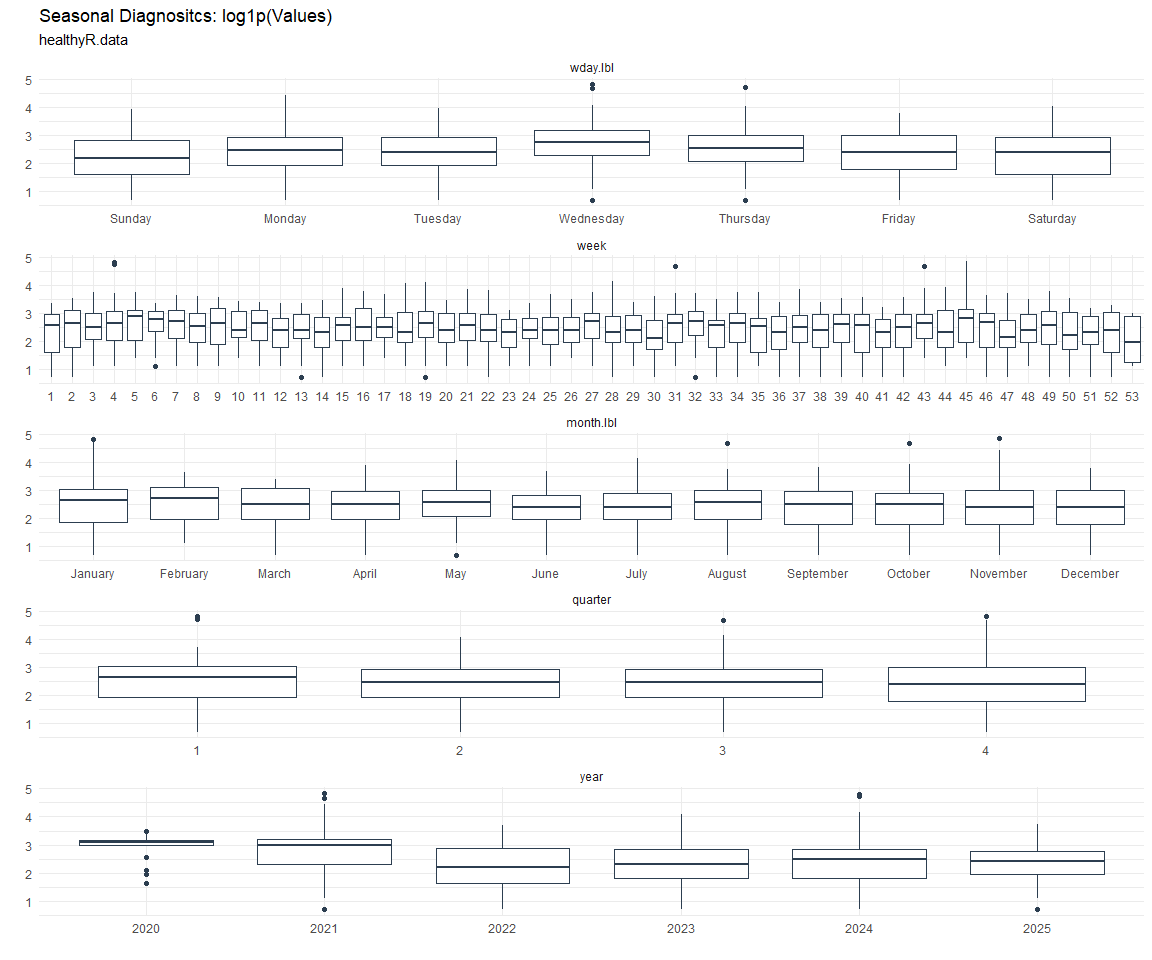
[[6]]
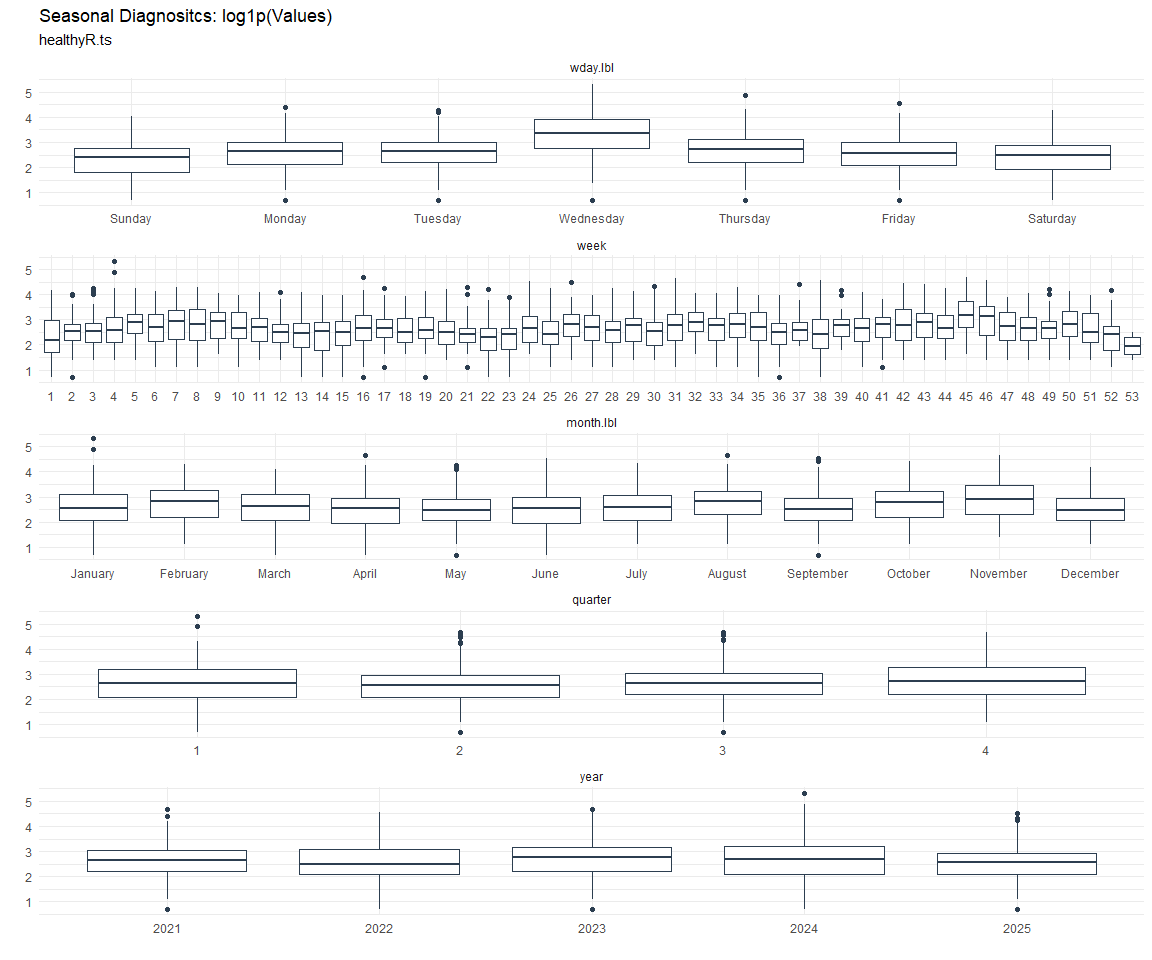
[[7]]
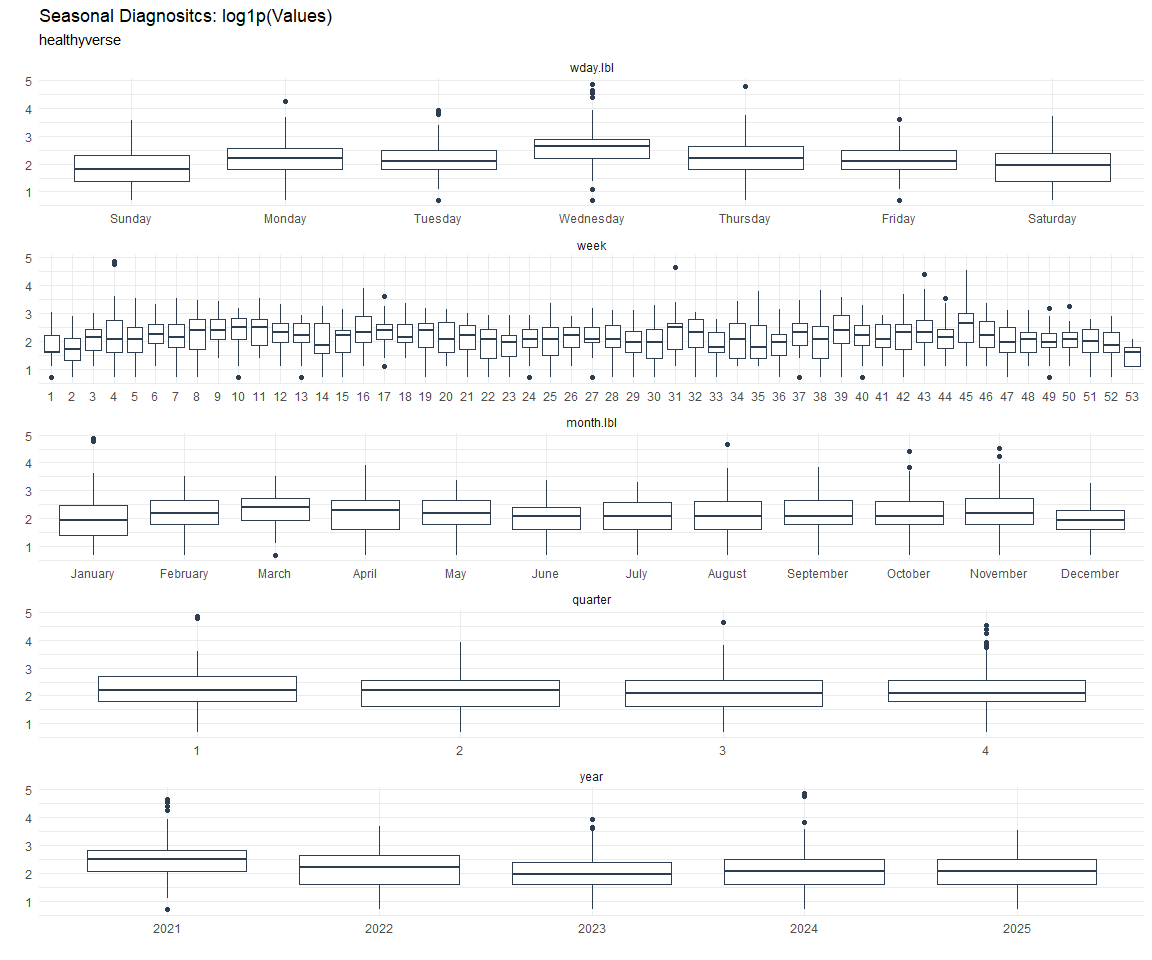
[[8]]
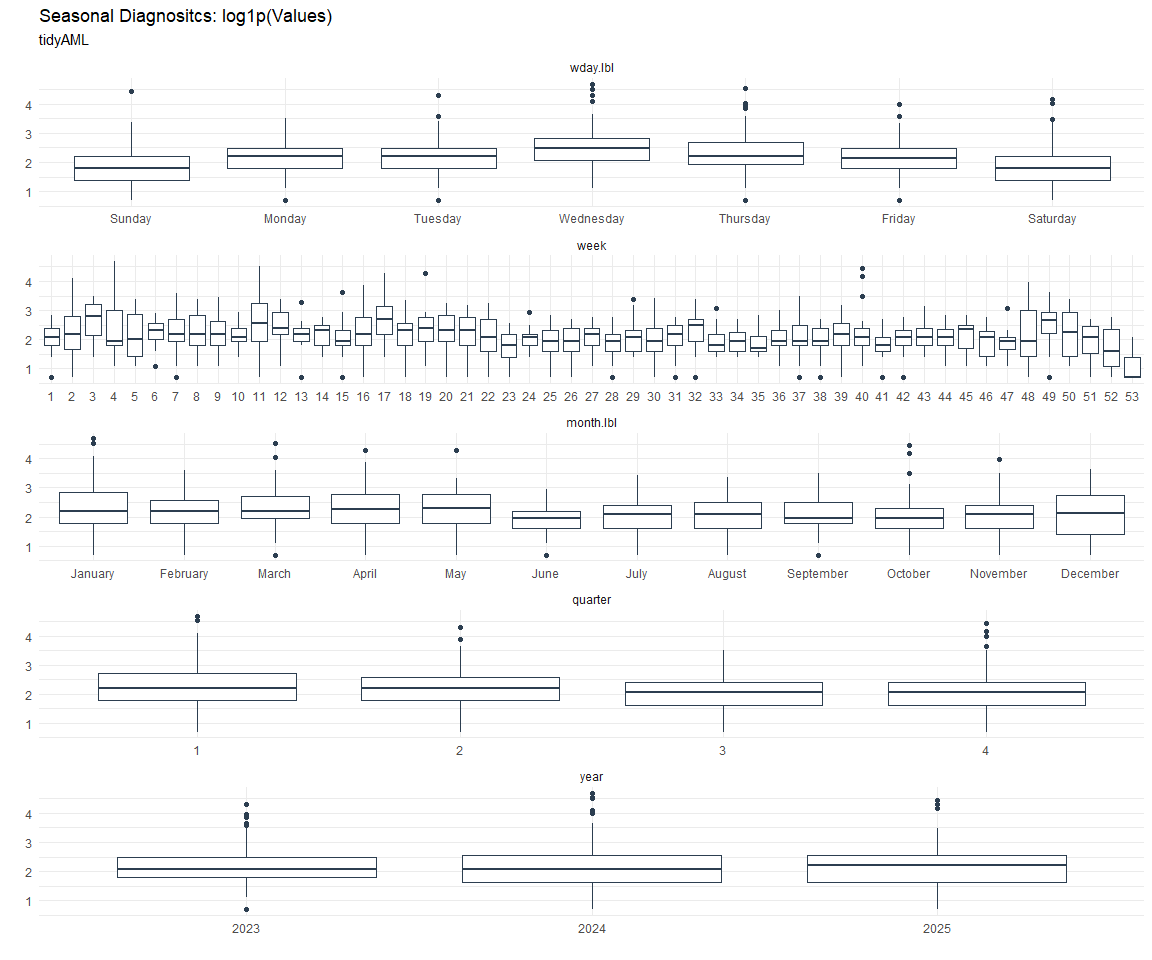
ACF and PACF Diagnostics:
[[1]]
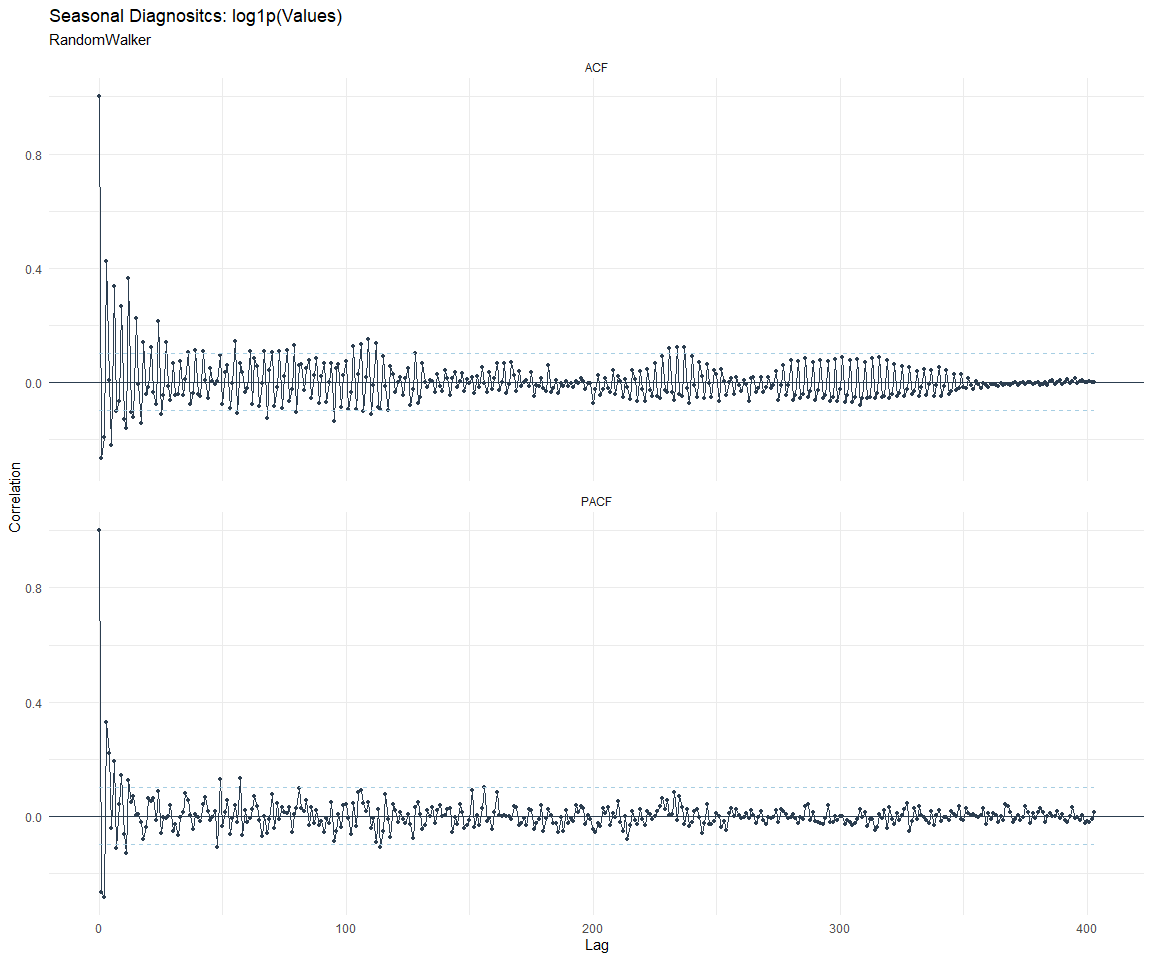
[[2]]
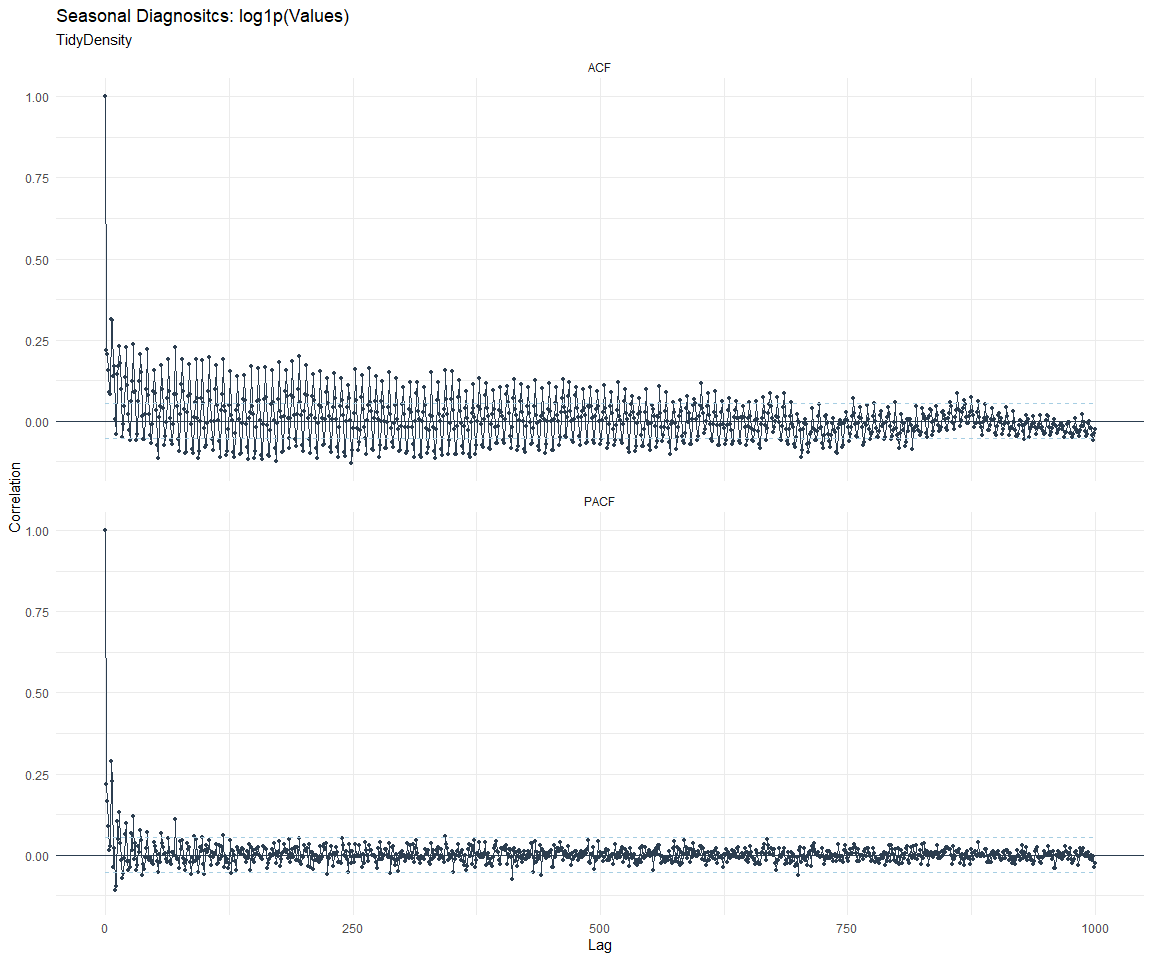
[[3]]
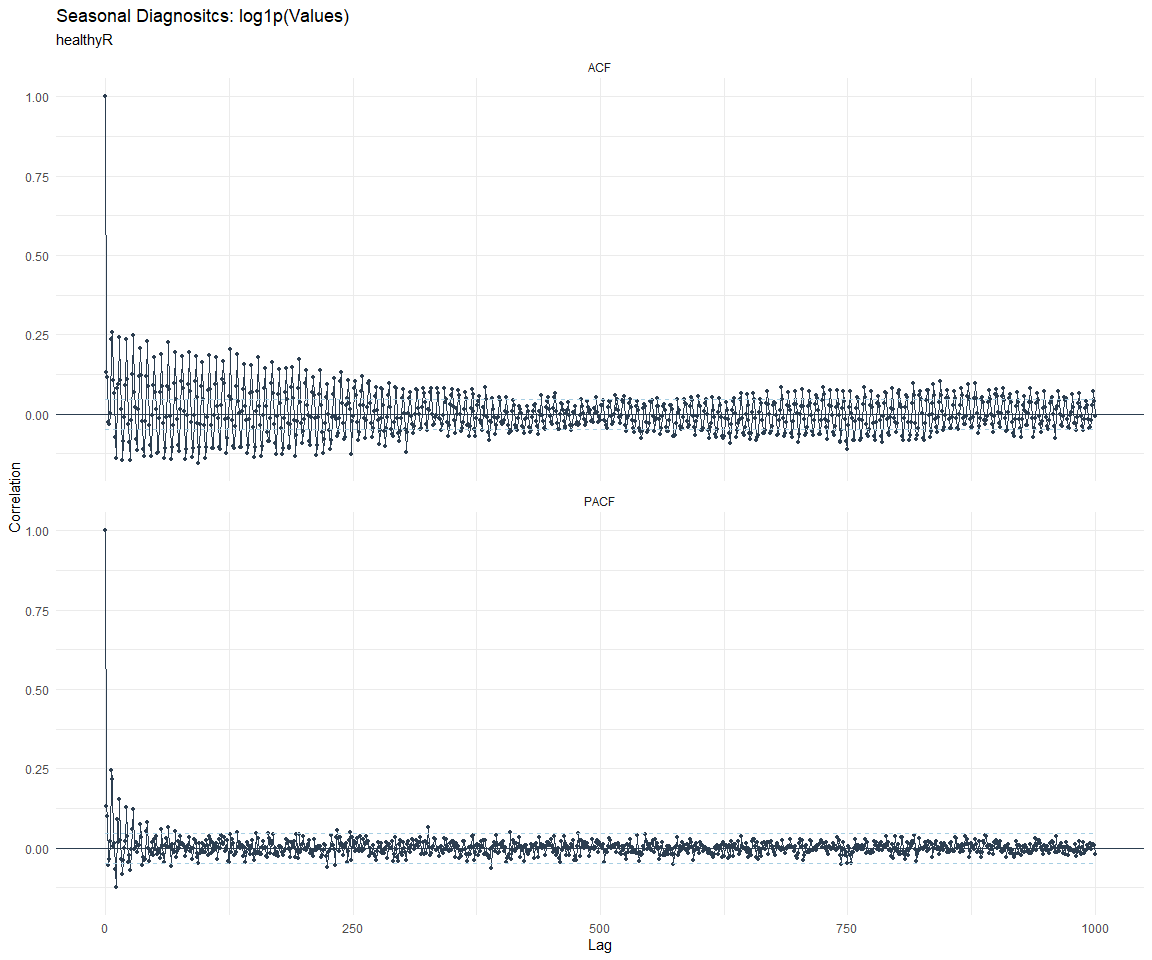
[[4]]
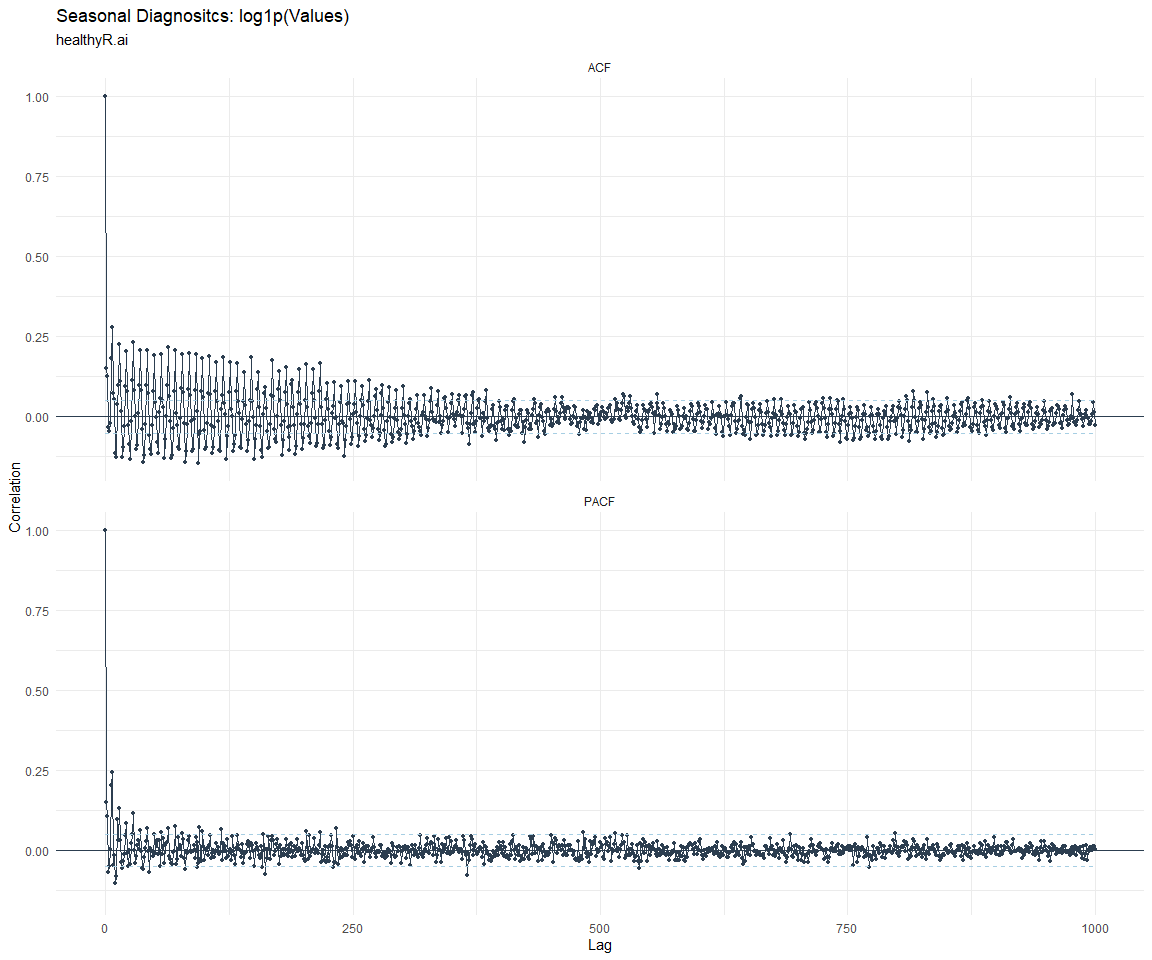
[[5]]

[[6]]

[[7]]

[[8]]

Feature Engineering
Now that we have our basic data and a shot of what it looks like, let’s
add some features to our data which can be very helpful in modeling.
Lets start by making a tibble that is aggregated by the day and
package, as we are going to be interested in forecasting the next 4
weeks or 28 days for each package. First lets get our base data.
Call:
stats::lm(formula = .formula, data = df)
Residuals:
Min 1Q Median 3Q Max
-147.37 -36.48 -11.20 26.99 819.76
Coefficients:
Estimate Std. Error
(Intercept) -1.863e+02 5.959e+01
date 1.138e-02 3.158e-03
lag(value, 1) 1.083e-01 2.310e-02
lag(value, 7) 8.966e-02 2.381e-02
lag(value, 14) 7.666e-02 2.377e-02
lag(value, 21) 8.327e-02 2.384e-02
lag(value, 28) 6.842e-02 2.375e-02
lag(value, 35) 5.116e-02 2.375e-02
lag(value, 42) 6.499e-02 2.386e-02
lag(value, 49) 6.326e-02 2.380e-02
month(date, label = TRUE).L -1.026e+01 4.969e+00
month(date, label = TRUE).Q 9.837e-01 4.868e+00
month(date, label = TRUE).C -1.545e+01 4.900e+00
month(date, label = TRUE)^4 -5.726e+00 4.903e+00
month(date, label = TRUE)^5 -6.417e+00 4.872e+00
month(date, label = TRUE)^6 1.418e+00 4.894e+00
month(date, label = TRUE)^7 -4.387e+00 4.835e+00
month(date, label = TRUE)^8 -4.016e+00 4.810e+00
month(date, label = TRUE)^9 2.803e+00 4.823e+00
month(date, label = TRUE)^10 9.203e-01 4.839e+00
month(date, label = TRUE)^11 -4.060e+00 4.826e+00
fourier_vec(date, type = "sin", K = 1, period = 7) -1.124e+01 2.200e+00
fourier_vec(date, type = "cos", K = 1, period = 7) 7.174e+00 2.277e+00
t value Pr(>|t|)
(Intercept) -3.126 0.001798 **
date 3.603 0.000323 ***
lag(value, 1) 4.688 2.96e-06 ***
lag(value, 7) 3.766 0.000171 ***
lag(value, 14) 3.226 0.001278 **
lag(value, 21) 3.493 0.000489 ***
lag(value, 28) 2.881 0.004016 **
lag(value, 35) 2.153 0.031415 *
lag(value, 42) 2.724 0.006512 **
lag(value, 49) 2.658 0.007920 **
month(date, label = TRUE).L -2.064 0.039184 *
month(date, label = TRUE).Q 0.202 0.839896
month(date, label = TRUE).C -3.153 0.001645 **
month(date, label = TRUE)^4 -1.168 0.242979
month(date, label = TRUE)^5 -1.317 0.187936
month(date, label = TRUE)^6 0.290 0.772060
month(date, label = TRUE)^7 -0.907 0.364290
month(date, label = TRUE)^8 -0.835 0.403809
month(date, label = TRUE)^9 0.581 0.561169
month(date, label = TRUE)^10 0.190 0.849195
month(date, label = TRUE)^11 -0.841 0.400320
fourier_vec(date, type = "sin", K = 1, period = 7) -5.109 3.60e-07 ***
fourier_vec(date, type = "cos", K = 1, period = 7) 3.150 0.001658 **
---
Signif. codes: 0 '***' 0.001 '**' 0.01 '*' 0.05 '.' 0.1 ' ' 1
Residual standard error: 59.2 on 1777 degrees of freedom
(49 observations deleted due to missingness)
Multiple R-squared: 0.2295, Adjusted R-squared: 0.22
F-statistic: 24.07 on 22 and 1777 DF, p-value: < 2.2e-16

NNS Forecasting
This is something I have been wanting to try for a while. The NNS
package is a great package for forecasting time series data.
library(NNS)
data_list <- base_data |>
select(package, value) |>
group_split(package)
data_list |>
imap(
\(x, idx) {
obj <- x
x <- obj |> pull(value) |> tail(7*52)
train_set_size <- length(x) - 56
pkg <- obj |> pluck(1) |> unique()
# sf <- NNS.seas(x, modulo = 7, plot = FALSE)$periods
seas <- t(
sapply(
1:25,
function(i) c(
i,
sqrt(
mean((
NNS.ARMA(x,
h = 28,
training.set = train_set_size,
method = "lin",
seasonal.factor = i,
plot=FALSE
) - tail(x, 28)) ^ 2)))
)
)
colnames(seas) <- c("Period", "RMSE")
sf <- seas[which.min(seas[, 2]), 1]
cat(paste0("Package: ", pkg, "\n"))
NNS.ARMA.optim(
variable = x,
h = 28,
training.set = train_set_size,
#seasonal.factor = seq(12, 60, 7),
seasonal.factor = sf,
pred.int = 0.95,
plot = TRUE
)
title(
sub = paste0("\n",
"Package: ", pkg, " - NNS Optimization")
)
}
)
Package: healthyR
[1] "CURRNET METHOD: lin"
[1] "COPY LATEST PARAMETERS DIRECTLY FOR NNS.ARMA() IF ERROR:"
[1] "NNS.ARMA(... method = 'lin' , seasonal.factor = c( 7 ) ...)"
[1] "CURRENT lin OBJECTIVE FUNCTION = 5.2175924447278"
[1] "BEST method = 'lin' PATH MEMBER = c( 7 )"
[1] "BEST lin OBJECTIVE FUNCTION = 5.2175924447278"
[1] "CURRNET METHOD: nonlin"
[1] "COPY LATEST PARAMETERS DIRECTLY FOR NNS.ARMA() IF ERROR:"
[1] "NNS.ARMA(... method = 'nonlin' , seasonal.factor = c( 7 ) ...)"
[1] "CURRENT nonlin OBJECTIVE FUNCTION = 6.43358060428004"
[1] "BEST method = 'nonlin' PATH MEMBER = c( 7 )"
[1] "BEST nonlin OBJECTIVE FUNCTION = 6.43358060428004"
[1] "CURRNET METHOD: both"
[1] "COPY LATEST PARAMETERS DIRECTLY FOR NNS.ARMA() IF ERROR:"
[1] "NNS.ARMA(... method = 'both' , seasonal.factor = c( 7 ) ...)"
[1] "CURRENT both OBJECTIVE FUNCTION = 6.13044794418033"
[1] "BEST method = 'both' PATH MEMBER = c( 7 )"
[1] "BEST both OBJECTIVE FUNCTION = 6.13044794418033"

Package: healthyR.ai
[1] "CURRNET METHOD: lin"
[1] "COPY LATEST PARAMETERS DIRECTLY FOR NNS.ARMA() IF ERROR:"
[1] "NNS.ARMA(... method = 'lin' , seasonal.factor = c( 4 ) ...)"
[1] "CURRENT lin OBJECTIVE FUNCTION = 17.1728128240806"
[1] "BEST method = 'lin' PATH MEMBER = c( 4 )"
[1] "BEST lin OBJECTIVE FUNCTION = 17.1728128240806"
[1] "CURRNET METHOD: nonlin"
[1] "COPY LATEST PARAMETERS DIRECTLY FOR NNS.ARMA() IF ERROR:"
[1] "NNS.ARMA(... method = 'nonlin' , seasonal.factor = c( 4 ) ...)"
[1] "CURRENT nonlin OBJECTIVE FUNCTION = 20.1758406149785"
[1] "BEST method = 'nonlin' PATH MEMBER = c( 4 )"
[1] "BEST nonlin OBJECTIVE FUNCTION = 20.1758406149785"
[1] "CURRNET METHOD: both"
[1] "COPY LATEST PARAMETERS DIRECTLY FOR NNS.ARMA() IF ERROR:"
[1] "NNS.ARMA(... method = 'both' , seasonal.factor = c( 4 ) ...)"
[1] "CURRENT both OBJECTIVE FUNCTION = 23.7028058827973"
[1] "BEST method = 'both' PATH MEMBER = c( 4 )"
[1] "BEST both OBJECTIVE FUNCTION = 23.7028058827973"

Package: healthyR.data
[1] "CURRNET METHOD: lin"
[1] "COPY LATEST PARAMETERS DIRECTLY FOR NNS.ARMA() IF ERROR:"
[1] "NNS.ARMA(... method = 'lin' , seasonal.factor = c( 23 ) ...)"
[1] "CURRENT lin OBJECTIVE FUNCTION = 10.8670352018108"
[1] "BEST method = 'lin' PATH MEMBER = c( 23 )"
[1] "BEST lin OBJECTIVE FUNCTION = 10.8670352018108"
[1] "CURRNET METHOD: nonlin"
[1] "COPY LATEST PARAMETERS DIRECTLY FOR NNS.ARMA() IF ERROR:"
[1] "NNS.ARMA(... method = 'nonlin' , seasonal.factor = c( 23 ) ...)"
[1] "CURRENT nonlin OBJECTIVE FUNCTION = 7.53966708732917"
[1] "BEST method = 'nonlin' PATH MEMBER = c( 23 )"
[1] "BEST nonlin OBJECTIVE FUNCTION = 7.53966708732917"
[1] "CURRNET METHOD: both"
[1] "COPY LATEST PARAMETERS DIRECTLY FOR NNS.ARMA() IF ERROR:"
[1] "NNS.ARMA(... method = 'both' , seasonal.factor = c( 23 ) ...)"
[1] "CURRENT both OBJECTIVE FUNCTION = 7.93788670604438"
[1] "BEST method = 'both' PATH MEMBER = c( 23 )"
[1] "BEST both OBJECTIVE FUNCTION = 7.93788670604438"

Package: healthyR.ts
[1] "CURRNET METHOD: lin"
[1] "COPY LATEST PARAMETERS DIRECTLY FOR NNS.ARMA() IF ERROR:"
[1] "NNS.ARMA(... method = 'lin' , seasonal.factor = c( 19 ) ...)"
[1] "CURRENT lin OBJECTIVE FUNCTION = 21.2659409870562"
[1] "BEST method = 'lin' PATH MEMBER = c( 19 )"
[1] "BEST lin OBJECTIVE FUNCTION = 21.2659409870562"
[1] "CURRNET METHOD: nonlin"
[1] "COPY LATEST PARAMETERS DIRECTLY FOR NNS.ARMA() IF ERROR:"
[1] "NNS.ARMA(... method = 'nonlin' , seasonal.factor = c( 19 ) ...)"
[1] "CURRENT nonlin OBJECTIVE FUNCTION = 21.141859716198"
[1] "BEST method = 'nonlin' PATH MEMBER = c( 19 )"
[1] "BEST nonlin OBJECTIVE FUNCTION = 21.141859716198"
[1] "CURRNET METHOD: both"
[1] "COPY LATEST PARAMETERS DIRECTLY FOR NNS.ARMA() IF ERROR:"
[1] "NNS.ARMA(... method = 'both' , seasonal.factor = c( 19 ) ...)"
[1] "CURRENT both OBJECTIVE FUNCTION = 21.0401615913755"
[1] "BEST method = 'both' PATH MEMBER = c( 19 )"
[1] "BEST both OBJECTIVE FUNCTION = 21.0401615913755"

Package: healthyverse
[1] "CURRNET METHOD: lin"
[1] "COPY LATEST PARAMETERS DIRECTLY FOR NNS.ARMA() IF ERROR:"
[1] "NNS.ARMA(... method = 'lin' , seasonal.factor = c( 4 ) ...)"
[1] "CURRENT lin OBJECTIVE FUNCTION = 7.34866993992594"
[1] "BEST method = 'lin' PATH MEMBER = c( 4 )"
[1] "BEST lin OBJECTIVE FUNCTION = 7.34866993992594"
[1] "CURRNET METHOD: nonlin"
[1] "COPY LATEST PARAMETERS DIRECTLY FOR NNS.ARMA() IF ERROR:"
[1] "NNS.ARMA(... method = 'nonlin' , seasonal.factor = c( 4 ) ...)"
[1] "CURRENT nonlin OBJECTIVE FUNCTION = 11.8963659382357"
[1] "BEST method = 'nonlin' PATH MEMBER = c( 4 )"
[1] "BEST nonlin OBJECTIVE FUNCTION = 11.8963659382357"
[1] "CURRNET METHOD: both"
[1] "COPY LATEST PARAMETERS DIRECTLY FOR NNS.ARMA() IF ERROR:"
[1] "NNS.ARMA(... method = 'both' , seasonal.factor = c( 4 ) ...)"
[1] "CURRENT both OBJECTIVE FUNCTION = 14.9202080980749"
[1] "BEST method = 'both' PATH MEMBER = c( 4 )"
[1] "BEST both OBJECTIVE FUNCTION = 14.9202080980749"

Package: RandomWalker
[1] "CURRNET METHOD: lin"
[1] "COPY LATEST PARAMETERS DIRECTLY FOR NNS.ARMA() IF ERROR:"
[1] "NNS.ARMA(... method = 'lin' , seasonal.factor = c( 23 ) ...)"
[1] "CURRENT lin OBJECTIVE FUNCTION = 11.6072700751069"
[1] "BEST method = 'lin' PATH MEMBER = c( 23 )"
[1] "BEST lin OBJECTIVE FUNCTION = 11.6072700751069"
[1] "CURRNET METHOD: nonlin"
[1] "COPY LATEST PARAMETERS DIRECTLY FOR NNS.ARMA() IF ERROR:"
[1] "NNS.ARMA(... method = 'nonlin' , seasonal.factor = c( 23 ) ...)"
[1] "CURRENT nonlin OBJECTIVE FUNCTION = 8.43659918453205"
[1] "BEST method = 'nonlin' PATH MEMBER = c( 23 )"
[1] "BEST nonlin OBJECTIVE FUNCTION = 8.43659918453205"
[1] "CURRNET METHOD: both"
[1] "COPY LATEST PARAMETERS DIRECTLY FOR NNS.ARMA() IF ERROR:"
[1] "NNS.ARMA(... method = 'both' , seasonal.factor = c( 23 ) ...)"
[1] "CURRENT both OBJECTIVE FUNCTION = 9.32424584198708"
[1] "BEST method = 'both' PATH MEMBER = c( 23 )"
[1] "BEST both OBJECTIVE FUNCTION = 9.32424584198708"

Package: tidyAML
[1] "CURRNET METHOD: lin"
[1] "COPY LATEST PARAMETERS DIRECTLY FOR NNS.ARMA() IF ERROR:"
[1] "NNS.ARMA(... method = 'lin' , seasonal.factor = c( 1 ) ...)"
[1] "CURRENT lin OBJECTIVE FUNCTION = 142.277623209315"
[1] "BEST method = 'lin' PATH MEMBER = c( 1 )"
[1] "BEST lin OBJECTIVE FUNCTION = 142.277623209315"
[1] "CURRNET METHOD: nonlin"
[1] "COPY LATEST PARAMETERS DIRECTLY FOR NNS.ARMA() IF ERROR:"
[1] "NNS.ARMA(... method = 'nonlin' , seasonal.factor = c( 1 ) ...)"
[1] "CURRENT nonlin OBJECTIVE FUNCTION = 126.94013917144"
[1] "BEST method = 'nonlin' PATH MEMBER = c( 1 )"
[1] "BEST nonlin OBJECTIVE FUNCTION = 126.94013917144"
[1] "CURRNET METHOD: both"
[1] "COPY LATEST PARAMETERS DIRECTLY FOR NNS.ARMA() IF ERROR:"
[1] "NNS.ARMA(... method = 'both' , seasonal.factor = c( 1 ) ...)"
[1] "CURRENT both OBJECTIVE FUNCTION = 95.9576377056693"
[1] "BEST method = 'both' PATH MEMBER = c( 1 )"
[1] "BEST both OBJECTIVE FUNCTION = 95.9576377056693"

Package: TidyDensity
[1] "CURRNET METHOD: lin"
[1] "COPY LATEST PARAMETERS DIRECTLY FOR NNS.ARMA() IF ERROR:"
[1] "NNS.ARMA(... method = 'lin' , seasonal.factor = c( 7 ) ...)"
[1] "CURRENT lin OBJECTIVE FUNCTION = 10.9730610088761"
[1] "BEST method = 'lin' PATH MEMBER = c( 7 )"
[1] "BEST lin OBJECTIVE FUNCTION = 10.9730610088761"
[1] "CURRNET METHOD: nonlin"
[1] "COPY LATEST PARAMETERS DIRECTLY FOR NNS.ARMA() IF ERROR:"
[1] "NNS.ARMA(... method = 'nonlin' , seasonal.factor = c( 7 ) ...)"
[1] "CURRENT nonlin OBJECTIVE FUNCTION = 8.34108303662068"
[1] "BEST method = 'nonlin' PATH MEMBER = c( 7 )"
[1] "BEST nonlin OBJECTIVE FUNCTION = 8.34108303662068"
[1] "CURRNET METHOD: both"
[1] "COPY LATEST PARAMETERS DIRECTLY FOR NNS.ARMA() IF ERROR:"
[1] "NNS.ARMA(... method = 'both' , seasonal.factor = c( 7 ) ...)"
[1] "CURRENT both OBJECTIVE FUNCTION = 9.4617809019988"
[1] "BEST method = 'both' PATH MEMBER = c( 7 )"
[1] "BEST both OBJECTIVE FUNCTION = 9.4617809019988"

[[1]]
NULL
[[2]]
NULL
[[3]]
NULL
[[4]]
NULL
[[5]]
NULL
[[6]]
NULL
[[7]]
NULL
[[8]]
NULL
Pre-Processing
Now we are going to do some basic pre-processing.
data_padded_tbl <- base_data %>%
pad_by_time(
.date_var = date,
.pad_value = 0
)
# Get log interval and standardization parameters
log_params <- liv(data_padded_tbl$value, limit_lower = 0, offset = 1, silent = TRUE)
limit_lower <- log_params$limit_lower
limit_upper <- log_params$limit_upper
offset <- log_params$offset
data_liv_tbl <- data_padded_tbl %>%
# Get log interval transform
mutate(value_trans = liv(value, limit_lower = 0, offset = 1, silent = TRUE)$log_scaled)
# Get Standardization Params
std_params <- standard_vec(data_liv_tbl$value_trans, silent = TRUE)
std_mean <- std_params$mean
std_sd <- std_params$sd
data_transformed_tbl <- data_liv_tbl %>%
group_by(package) %>%
# get standardization
mutate(value_trans = standard_vec(value_trans, silent = TRUE)$standard_scaled) %>%
tk_augment_fourier(
.date_var = date,
.periods = c(7, 14, 30, 90, 180),
.K = 2
) %>%
tk_augment_timeseries_signature(
.date_var = date
) %>%
ungroup() %>%
select(-c(value, -year.iso))
Since this is panel data we can follow one of two different modeling strategies. We can search for a global model in the panel data or we can use nested forecasting finding the best model for each of the time series. Since we only have 5 panels, we will use nested forecasting.
To do this we will use the nest_timeseries and
split_nested_timeseries functions to create a nested tibble.
horizon <- 4*7
nested_data_tbl <- data_transformed_tbl %>%
# 0. Filter out column where package is NA
filter(!is.na(package)) %>%
# 1. Extending: We'll predict n days into the future.
extend_timeseries(
.id_var = package,
.date_var = date,
.length_future = horizon
) %>%
# 2. Nesting: We'll group by id, and create a future dataset
# that forecasts n days of extended data and
# an actual dataset that contains n*2 days
nest_timeseries(
.id_var = package,
.length_future = horizon
#.length_actual = horizon*2
) %>%
# 3. Splitting: We'll take the actual data and create splits
# for accuracy and confidence interval estimation of n das (test)
# and the rest is training data
split_nested_timeseries(
.length_test = horizon
)
nested_data_tbl
# A tibble: 8 × 4
package .actual_data .future_data .splits
<fct> <list> <list> <list>
1 healthyR.data <tibble [1,840 × 50]> <tibble [28 × 50]> <split [1812|28]>
2 healthyR <tibble [1,832 × 50]> <tibble [28 × 50]> <split [1804|28]>
3 healthyR.ts <tibble [1,775 × 50]> <tibble [28 × 50]> <split [1747|28]>
4 healthyverse <tibble [1,745 × 50]> <tibble [28 × 50]> <split [1717|28]>
5 healthyR.ai <tibble [1,574 × 50]> <tibble [28 × 50]> <split [1546|28]>
6 TidyDensity <tibble [1,425 × 50]> <tibble [28 × 50]> <split [1397|28]>
7 tidyAML <tibble [1,032 × 50]> <tibble [28 × 50]> <split [1004|28]>
8 RandomWalker <tibble [455 × 50]> <tibble [28 × 50]> <split [427|28]>
Now it is time to make some recipes and models using the modeltime workflow.
Modeltime Workflow
Recipe Object
recipe_base <- recipe(
value_trans ~ .
, data = extract_nested_test_split(nested_data_tbl)
)
recipe_base
recipe_date <- recipe(
value_trans ~ date
, data = extract_nested_test_split(nested_data_tbl)
)
Models
# Models ------------------------------------------------------------------
# Auto ARIMA --------------------------------------------------------------
model_spec_arima_no_boost <- arima_reg() %>%
set_engine(engine = "auto_arima")
wflw_auto_arima <- workflow() %>%
add_recipe(recipe = recipe_date) %>%
add_model(model_spec_arima_no_boost)
# NNETAR ------------------------------------------------------------------
model_spec_nnetar <- nnetar_reg(
mode = "regression"
, seasonal_period = "auto"
) %>%
set_engine("nnetar")
wflw_nnetar <- workflow() %>%
add_recipe(recipe = recipe_base) %>%
add_model(model_spec_nnetar)
# TSLM --------------------------------------------------------------------
model_spec_lm <- linear_reg() %>%
set_engine("lm")
wflw_lm <- workflow() %>%
add_recipe(recipe = recipe_base) %>%
add_model(model_spec_lm)
# MARS --------------------------------------------------------------------
model_spec_mars <- mars(mode = "regression") %>%
set_engine("earth")
wflw_mars <- workflow() %>%
add_recipe(recipe = recipe_date) %>%
add_model(model_spec_mars)
Nested Modeltime Tables
nested_modeltime_tbl <- modeltime_nested_fit(
# Nested Data
nested_data = nested_data_tbl,
control = control_nested_fit(
verbose = TRUE,
allow_par = FALSE
),
# Add workflows
wflw_auto_arima,
wflw_lm,
wflw_mars,
wflw_nnetar
)
nested_modeltime_tbl <- nested_modeltime_tbl[!is.na(nested_modeltime_tbl$package),]
Model Accuracy
nested_modeltime_tbl %>%
extract_nested_test_accuracy() %>%
filter(!is.na(package)) %>%
knitr::kable()
| package | .model_id | .model_desc | .type | mae | mape | mase | smape | rmse | rsq |
|---|---|---|---|---|---|---|---|---|---|
| healthyR.data | 1 | ARIMA | Test | 0.7283596 | 172.32578 | 0.7084059 | 147.2195 | 0.8200320 | 0.0004834 |
| healthyR.data | 2 | LM | Test | 0.6659373 | 224.99973 | 0.6476937 | 119.7955 | 0.7994281 | 0.0597221 |
| healthyR.data | 3 | EARTH | Test | 1.1029543 | 504.29529 | 1.0727384 | 118.6934 | 1.3431714 | 0.0127157 |
| healthyR.data | 4 | NNAR | Test | 0.7460935 | 241.31352 | 0.7256539 | 133.9408 | 0.8950873 | 0.0001319 |
| healthyR | 1 | ARIMA | Test | 0.5033889 | 266.71707 | 0.8604906 | 140.9911 | 0.6257854 | 0.0029176 |
| healthyR | 2 | LM | Test | 0.4826050 | 449.38269 | 0.8249626 | 104.8226 | 0.5793575 | 0.1385617 |
| healthyR | 3 | EARTH | Test | 0.7516971 | 764.05415 | 1.2849474 | 111.9812 | 0.8811326 | 0.0935887 |
| healthyR | 4 | NNAR | Test | 0.4123123 | 199.75087 | 0.7048046 | 113.8066 | 0.5017408 | 0.2345093 |
| healthyR.ts | 1 | ARIMA | Test | 0.5978137 | 114.60855 | 0.7762101 | 159.8154 | 0.7455624 | 0.0359105 |
| healthyR.ts | 2 | LM | Test | 0.6703808 | 145.24418 | 0.8704324 | 129.1245 | 0.8358226 | 0.0020344 |
| healthyR.ts | 3 | EARTH | Test | 0.5339835 | 134.58600 | 0.6933321 | 101.8256 | 0.7018769 | 0.0618091 |
| healthyR.ts | 4 | NNAR | Test | 0.7694902 | 156.72354 | 0.9991175 | 151.3359 | 0.9422121 | 0.0097233 |
| healthyverse | 1 | ARIMA | Test | 0.6743785 | 97.39765 | 0.6736234 | 116.1145 | 0.8869407 | 0.0007238 |
| healthyverse | 2 | LM | Test | 0.7683652 | 137.40024 | 0.7675049 | 120.0752 | 0.9013803 | 0.0081141 |
| healthyverse | 3 | EARTH | Test | 1.0643946 | 283.55476 | 1.0632029 | 110.6372 | 1.2432926 | 0.0190930 |
| healthyverse | 4 | NNAR | Test | 0.7618218 | 140.95879 | 0.7609689 | 126.3094 | 0.9045790 | 0.0236366 |
| healthyR.ai | 1 | ARIMA | Test | 0.7858894 | 114.14279 | 0.9024941 | 151.7625 | 0.9138999 | 0.3042449 |
| healthyR.ai | 2 | LM | Test | 0.8758550 | 163.91053 | 1.0058082 | 132.2528 | 1.0784017 | 0.0727373 |
| healthyR.ai | 3 | EARTH | Test | 2.3989266 | 774.03191 | 2.7548623 | 135.5210 | 2.8445943 | 0.3968339 |
| healthyR.ai | 4 | NNAR | Test | 0.8588094 | 137.16037 | 0.9862335 | 137.9731 | 1.0572319 | 0.0222469 |
| TidyDensity | 1 | ARIMA | Test | 1.0149567 | 179.17488 | 0.6486094 | 161.2578 | 1.1526099 | 0.1309207 |
| TidyDensity | 2 | LM | Test | 0.9471489 | 122.40199 | 0.6052768 | 158.3925 | 1.1349209 | 0.0193278 |
| TidyDensity | 3 | EARTH | Test | 0.9200465 | 94.22875 | 0.5879569 | 165.6449 | 1.1413176 | 0.0263725 |
| TidyDensity | 4 | NNAR | Test | 1.0618212 | 163.31818 | 0.6785583 | 157.1827 | 1.1974671 | 0.0183726 |
| tidyAML | 1 | ARIMA | Test | 0.5536957 | 124.77945 | 0.6741471 | 124.8103 | 0.7349982 | 0.0000091 |
| tidyAML | 2 | LM | Test | 0.5792351 | 206.72125 | 0.7052425 | 130.8985 | 0.7383391 | 0.1035182 |
| tidyAML | 3 | EARTH | Test | 1.0589417 | 476.42069 | 1.2893049 | 125.8480 | 1.2096838 | 0.0023937 |
| tidyAML | 4 | NNAR | Test | 0.7146013 | 333.95111 | 0.8700562 | 115.6533 | 0.8383834 | 0.0811746 |
| RandomWalker | 1 | ARIMA | Test | 0.6568350 | 120.29770 | 0.6858403 | 141.7613 | 0.8165203 | 0.0662191 |
| RandomWalker | 2 | LM | Test | 0.6917081 | 146.56179 | 0.7222533 | 152.2283 | 0.8247919 | 0.0470930 |
| RandomWalker | 3 | EARTH | Test | 0.7981137 | 195.75073 | 0.8333577 | 164.1493 | 0.8595254 | 0.1113190 |
| RandomWalker | 4 | NNAR | Test | 0.6779859 | 179.35184 | 0.7079252 | 154.6735 | 0.8192475 | 0.0648154 |
Plot Models
nested_modeltime_tbl %>%
extract_nested_test_forecast() %>%
group_by(package) %>%
filter_by_time(.date_var = .index, .start_date = max(.index) - 60) %>%
ungroup() %>%
plot_modeltime_forecast(
.interactive = FALSE,
.conf_interval_show = FALSE,
.facet_scales = "free"
) +
theme_minimal() +
facet_wrap(~ package, nrow = 3) +
theme(legend.position = "bottom")

Best Model
best_nested_modeltime_tbl <- nested_modeltime_tbl %>%
modeltime_nested_select_best(
metric = "rmse",
minimize = TRUE,
filter_test_forecasts = TRUE
)
best_nested_modeltime_tbl %>%
extract_nested_best_model_report()
# Nested Modeltime Table
# A tibble: 8 × 10
package .model_id .model_desc .type mae mape mase smape rmse rsq
<fct> <int> <chr> <chr> <dbl> <dbl> <dbl> <dbl> <dbl> <dbl>
1 healthyR.da… 2 LM Test 0.666 225. 0.648 120. 0.799 5.97e-2
2 healthyR 4 NNAR Test 0.412 200. 0.705 114. 0.502 2.35e-1
3 healthyR.ts 3 EARTH Test 0.534 135. 0.693 102. 0.702 6.18e-2
4 healthyverse 1 ARIMA Test 0.674 97.4 0.674 116. 0.887 7.24e-4
5 healthyR.ai 1 ARIMA Test 0.786 114. 0.902 152. 0.914 3.04e-1
6 TidyDensity 2 LM Test 0.947 122. 0.605 158. 1.13 1.93e-2
7 tidyAML 1 ARIMA Test 0.554 125. 0.674 125. 0.735 9.05e-6
8 RandomWalker 1 ARIMA Test 0.657 120. 0.686 142. 0.817 6.62e-2
best_nested_modeltime_tbl %>%
extract_nested_test_forecast() %>%
#filter(!is.na(.model_id)) %>%
group_by(package) %>%
filter_by_time(.date_var = .index, .start_date = max(.index) - 60) %>%
ungroup() %>%
plot_modeltime_forecast(
.interactive = FALSE,
.conf_interval_alpha = 0.2,
.facet_scales = "free"
) +
facet_wrap(~ package, nrow = 3) +
theme_minimal() +
theme(legend.position = "bottom")

Refitting and Future Forecast
Now that we have the best models, we can make our future forecasts.
nested_modeltime_refit_tbl <- best_nested_modeltime_tbl %>%
modeltime_nested_refit(
control = control_nested_refit(verbose = TRUE)
)
nested_modeltime_refit_tbl
# Nested Modeltime Table
# A tibble: 8 × 5
package .actual_data .future_data .splits .modeltime_tables
<fct> <list> <list> <list> <list>
1 healthyR.data <tibble> <tibble> <split [1812|28]> <mdl_tm_t [1 × 5]>
2 healthyR <tibble> <tibble> <split [1804|28]> <mdl_tm_t [1 × 5]>
3 healthyR.ts <tibble> <tibble> <split [1747|28]> <mdl_tm_t [1 × 5]>
4 healthyverse <tibble> <tibble> <split [1717|28]> <mdl_tm_t [1 × 5]>
5 healthyR.ai <tibble> <tibble> <split [1546|28]> <mdl_tm_t [1 × 5]>
6 TidyDensity <tibble> <tibble> <split [1397|28]> <mdl_tm_t [1 × 5]>
7 tidyAML <tibble> <tibble> <split [1004|28]> <mdl_tm_t [1 × 5]>
8 RandomWalker <tibble> <tibble> <split [427|28]> <mdl_tm_t [1 × 5]>
nested_modeltime_refit_tbl %>%
extract_nested_future_forecast() %>%
group_by(package) %>%
mutate(across(.value:.conf_hi, .fns = ~ standard_inv_vec(
x = .,
mean = std_mean,
sd = std_sd
)$standard_inverse_value)) %>%
mutate(across(.value:.conf_hi, .fns = ~ liiv(
x = .,
limit_lower = limit_lower,
limit_upper = limit_upper,
offset = offset
)$rescaled_v)) %>%
filter_by_time(.date_var = .index, .start_date = max(.index) - 60) %>%
ungroup() %>%
plot_modeltime_forecast(
.interactive = FALSE,
.conf_interval_alpha = 0.2,
.facet_scales = "free"
) +
facet_wrap(~ package, nrow = 3) +
theme_minimal() +
theme(legend.position = "bottom")
